Apollo 17
Day 5, part 2: Lunar Orbit Insertion
Corrected Transcript and Commentary Copyright © 2018-2022 by W. David Woods and Ben Feist. All rights reserved.
Last updated 2022-03-30
089:15:30 - This is Apollo Control at 89 hours, 15 minutes Ground Elapsed Time. Some 55 seconds until Apollo 17 comes from behind the Moon, on the start of the first Lunar Orbit. We're awaiting appearance of the spacecraft and word that the burn went successful, which apparently it has because the spacecraft without a burn would have appeared some 8 minutes ago. The ignition time is 88:54:21 in Ground Elapsed Time. Should be getting lock on fairly soon, zero. That was the theoretical acquisition time. Of course, it does take a few seconds for the ground station to lock on to the signal from the spacecraft. We're awaiting word from the communications officer that we have indeed gotten a signal and telemetry from the spacecraft.
089:17:00 Evans: Didn't [garble] me yet.
089:17:06 Evans: No, it's not in yet. Well, yes, it is. There's AOS limits right there.
089:17:14 Evans: I think we just passed Hertz and...
089:17:17 Fullerton: Hello there, America. We hear you talking.
089:17:31 Evans: Auto and Narrow. Yes, Auto and Narrow.
089:17:48 Evans: Good; I thought it dropped off. Hey, it dropped off.
089:17:55 Evans: Minus 43 and 345.
089:17:58 Fullerton: Hello, America; this is Houston. How do you: read?
089:18:01 Evans: Attitude? Yes, 65, 60, 8. Yes, we're in attitude.
089:18:21 Fullerton: America, Houston. Over.
089:18:42 Evans: Don't tell me the old High Gain crumped.
089:18:49 Evans: Okay. Let's see you're Manual...
089:19:08 Evans: Yes, we started to get it - a while ago.
089:19:11 Evans: Yes, put it in Auto and Narrow.
089:19:36 Evans: The time?
089:19:47 Evans: Yes, we're at the edge of Marginis.
089:20:05 - This is Apollo Control. Here in the Control Center we are hearing the crew aboard the spacecraft of Apollo 17 very clearly, however the ground has not be able to fully lock up on the spacecraft with the so-called uplink, on the voice uplink. And apparently it has to do with the 85-foot [26-metre] antenna at Goldstone. We're continuing to stand by until the 2-way communications are complete. An hour and 20 minutes before Loss Of Signal as we go across the face of the Moon, the front face of the Moon on the first lunar lrbit. At 89:20 and standing by, this is Apollo Control.
089:20:16 Evans: There's Al-Biruni over here.
089:21:02 Cernan: Okay. It came in then. There it goes. Hello!
089:21:13 Fullerton: Hello, America. How do you read Houston? Over.
089:21:18 Cernan: America - Houston, this is America. You can breathe easier. America has arrived on station for the challenge ahead.
089:21:27 Fullerton: Very good. We've been hearing you for a couple of minutes now. We've had a ground site problem, but you're loud and clear now.
089:21:37 Cernan: Okay. That's what we sort of thought, Gordo. The SPS burn could not have been more nominal. I've got some numbers for you, if you're ready to copy.
089:21:46 Fullerton: Go ahead.
089:21:55 Cernan: Okay, T
IG was on time. T
IG was on time, burn time was 6 plus 33, V
G is 2989.9; roll was 008; pitch, 357; yaw, 006; all at the end of the burn. Residuals; minus 0.3, plus 0.1, and 0. Delta-V
C was minus 6.8; oxidizer, 34.0; fuel, 34.5; unbalance is 110, decrease. The CMC holds us in a 170.3 by 52.5.
089:22:49 Fullerton: That sounds great, Gene.
089:22:54 Cernan: It was an auto ignition. It was an auto shutdown. I think any comments during the burn are on the tape. But, to me, it was probably the smoothest and quietest SPS burn I ever remember.
089:23:08 Fullerton: Roger.
089:23:10 Schmitt: Houston, this is Jack. The PUGS was erratic. It's the only thing I noticed that was off-nominal. It - it bounced ground a lot, in bouncing arou - initially for about a minute - around - oh, 1.8 decrease, then it gradually started to diverge from that to a more decrease, down to about 2.5 or make that 3 decrease. And I went to Decrease on the switch; and about the time of crossover, I had it at - oh, about 1 decrease and it crossed over and stabilized at zero, and I went to Normal and it stayed there the rest of the burn - until just near the end, it started to go decrease again.
089:24:02 Fullerton: Okay, we copy that, Jack.
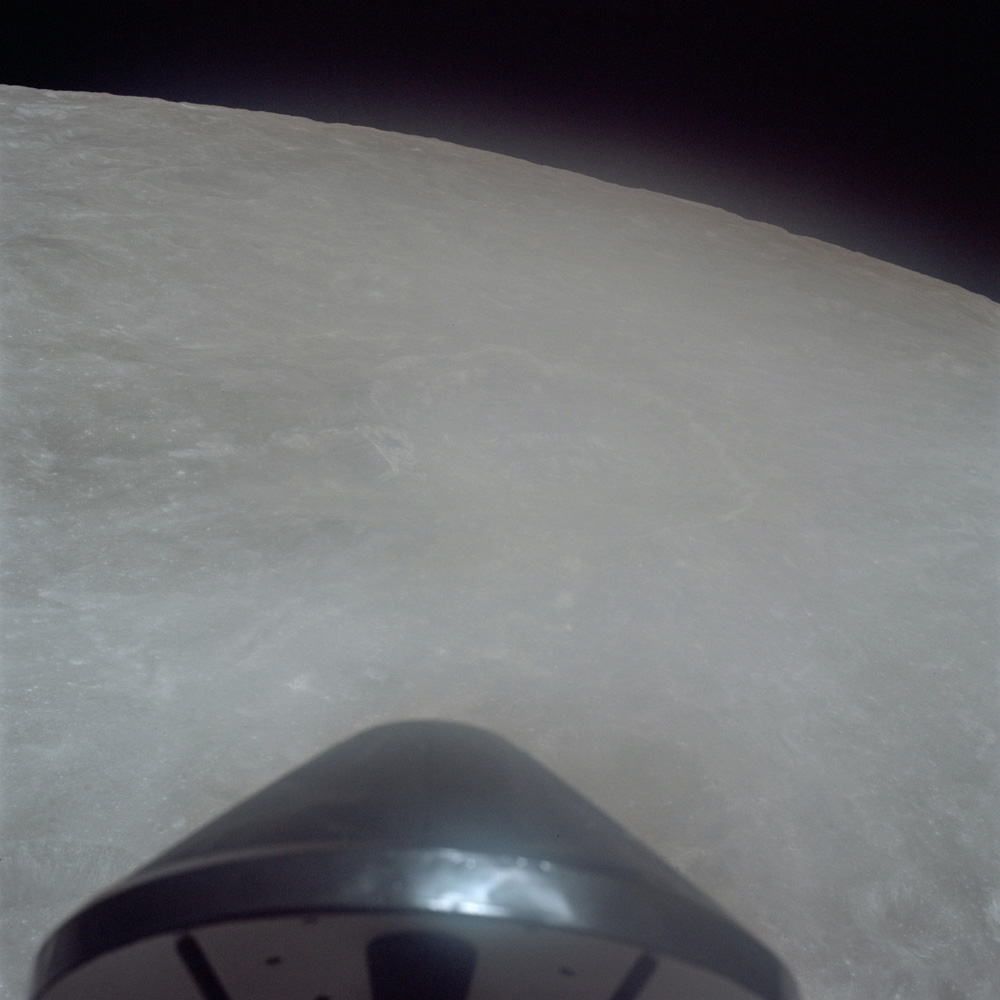
AS17-149-22780 - King crater and Rendezvous Radar antenna - JSC scan
089:24:06 Schmitt: Okay, Gordo, did you by any chance get the S-IVB impact?
089:24:12 Fullerton: We're - Okay, the new impact time for that is 89:39, so we haven't quite got there yet.
089:24:26 Cernan: Okay. Thank you.
089:24:29 Evans: And, Houston - Ron here. Something a little bit of a surprise to me. When I turned on bank A, the chamber pressure came up to 87 percent, and stayed there essentially. Five seconds later, I put on band B, the chamber pressure rose to 90 - about 91 - somewhere in that area. And then, throughout the burn, chamber pressure increased, which you'll see on the strip chart. But I was sure surprised at only 87 percent when we started it. It looked like the velocity gained versus time was correct throughout the burn, though. The maximum the chamber pressure ever got to was about 97 percent, and that was toward the end of the burn.
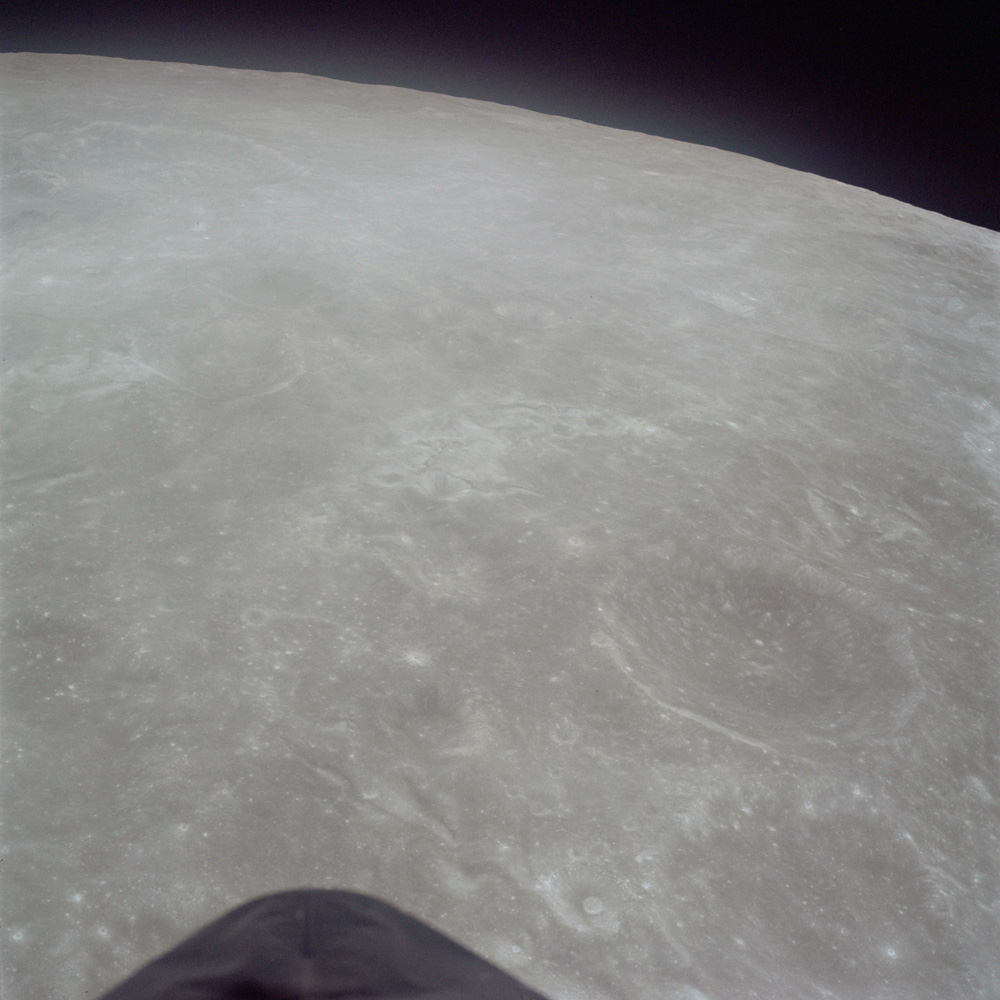
AS17-149-22781 - Firsov crater and Rendezvous Radar antenna - JSC scan
089:25:21 Fullerton: Roger, Ron.
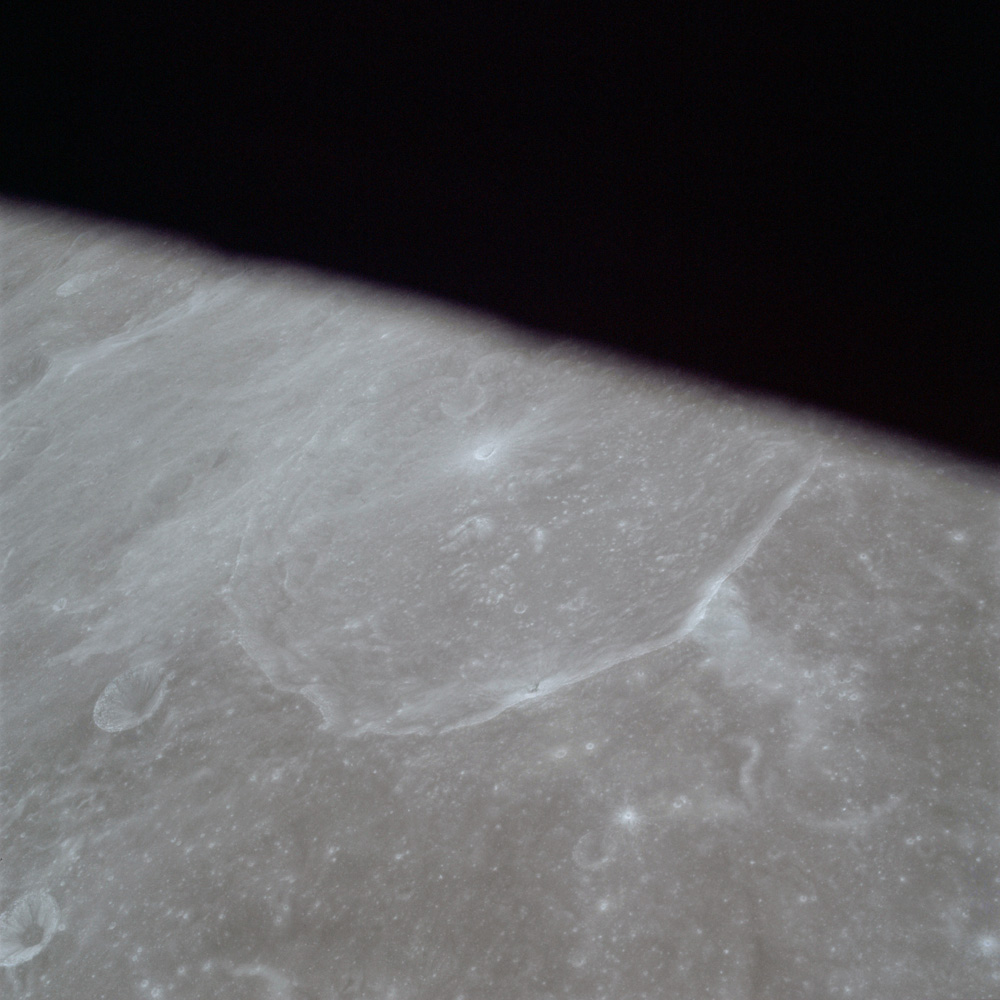
AS17-149-22782 - Lobachevsky crater - JSC scan
089:26:10 Cernan: A little disappointed here, Gordo. I brought an airborne and a ground geologist along with me and it took them until AOS to make sure they knew where we were.
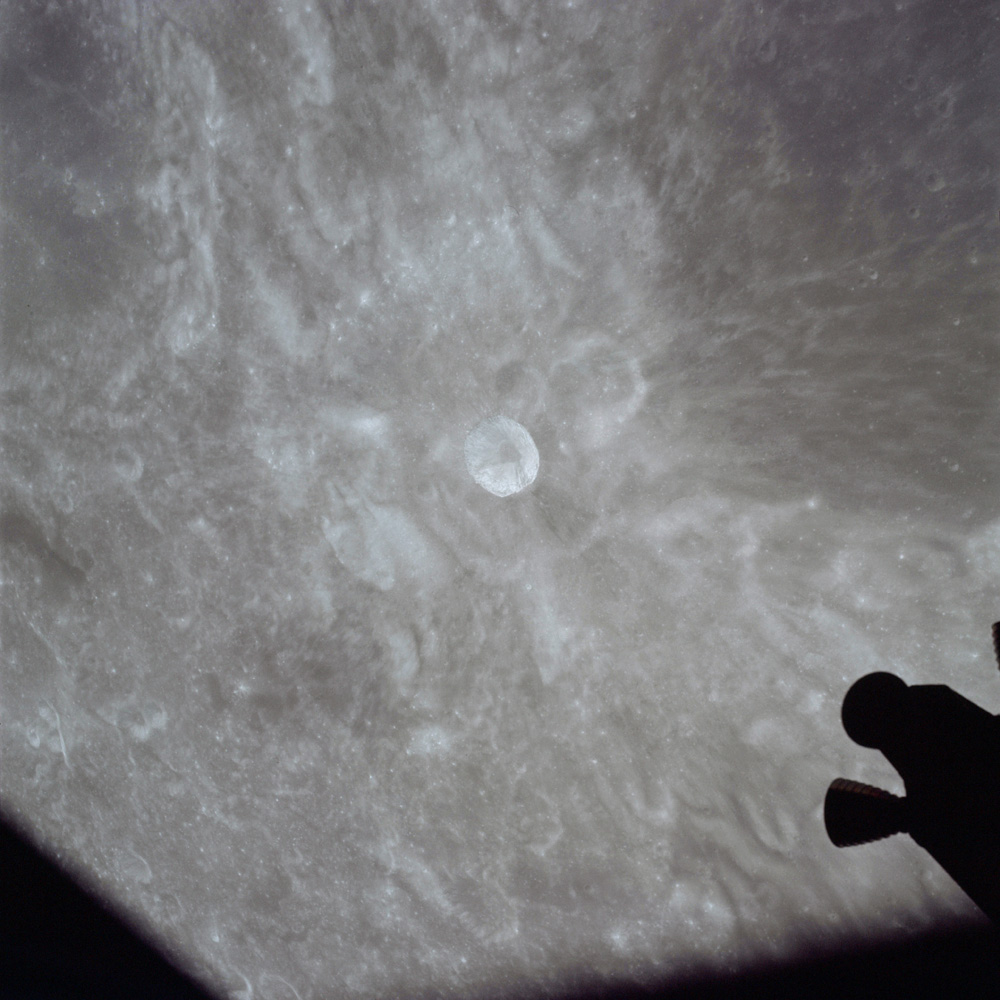
AS17-149-22783 - Fresh crater between Goddard (top right) and Al-Biruni (top left) - JSC scan
089:26:20 Evans: Ha, ha, ha. That's not true.
089:26:23 Fullerton: Roger.
089:26:25 Evans: My big problem was all the holes were hills when I first started. Looked just like you had the picture upside down.
089:26:32 Fullerton: Roger, Ron. I have a couple pan camera photo PADs for you.
089:26:50 Schmitt: Go ahead, Gordo.
089:26:52 Fullerton: Okay, the first one goes in the Flight Plan at 90:45, and the start time is 090:50:32. Stop time is 091:10:57. Go ahead.
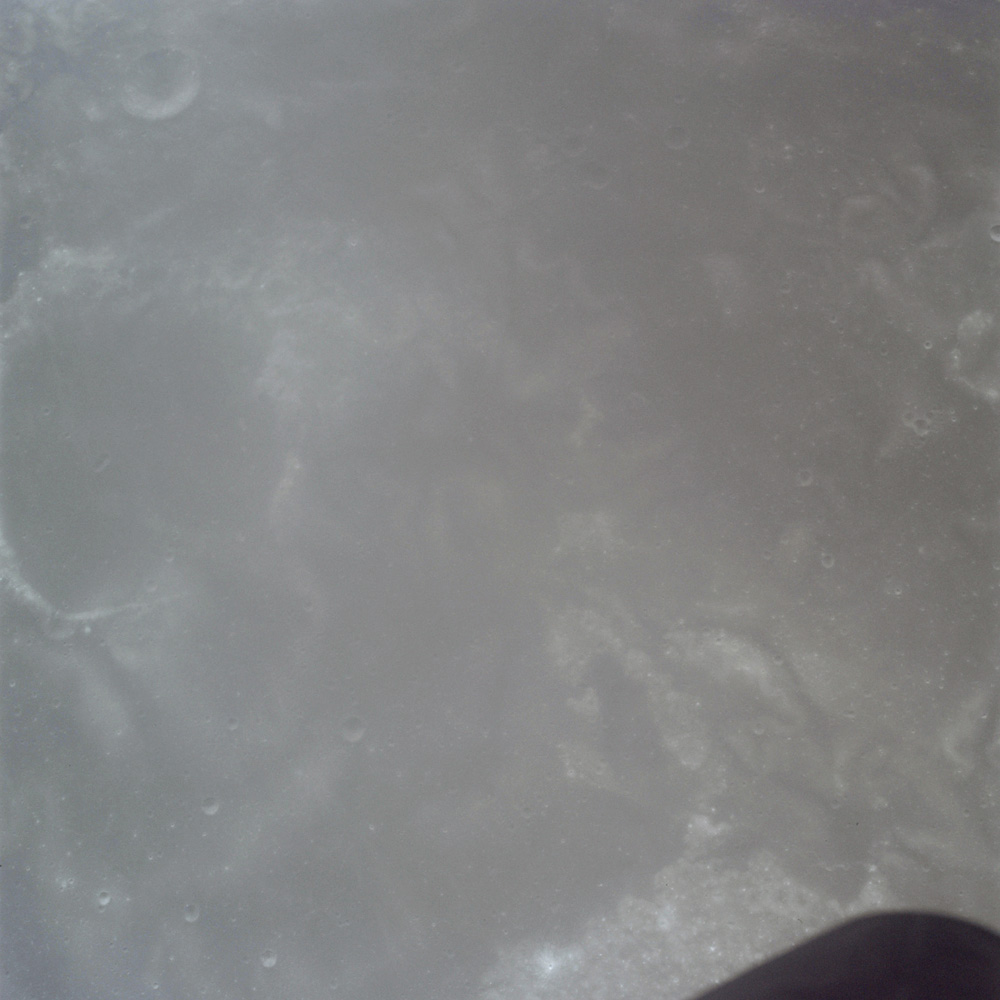
AS17-149-22784 - Western end of Mare Marginis - JSC scan
089:27:16 Schmitt: Okay, I got 090:50:32 and 091:10:57.
089:27:21 Fullerton: Okay, and next one goes on the next page. Start time is 091:18:05. Stop time is 091:27:43.
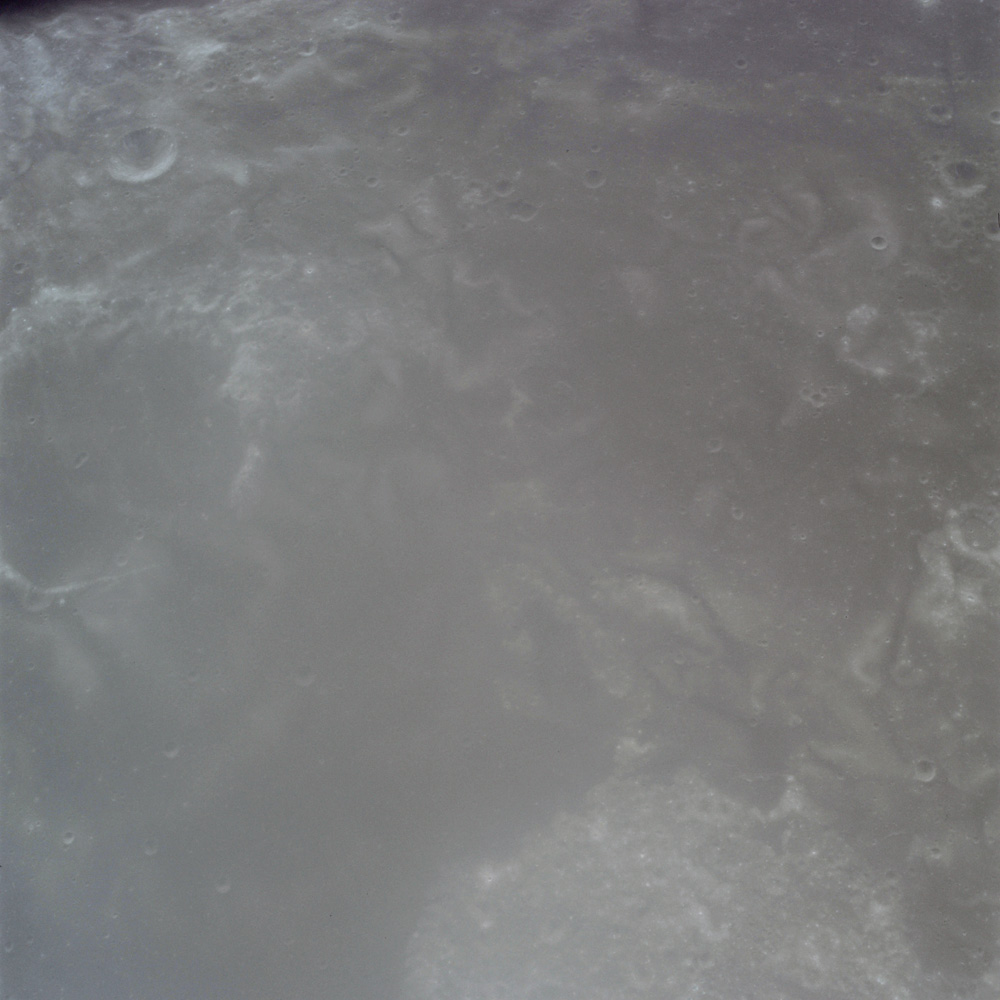
AS17-149-22785 - Western end of Mare Marginis - JSC scan
089:27:45 Schmitt: 91:18:05, 91:27:43.
089:27:53 Fullerton: That's right.
089:27:57 Schmitt: Okay, Gordy, I turned the Pan Camera, Off, there about 30 seconds ago and the post-SPS burn checks are complete. Logic - no, that's - well, just a minute. The post-SPS burns are complete down to Logic Power, two, to Deploy/Retract. No, that's your Flight Plan. Okay? Mode is Standby.
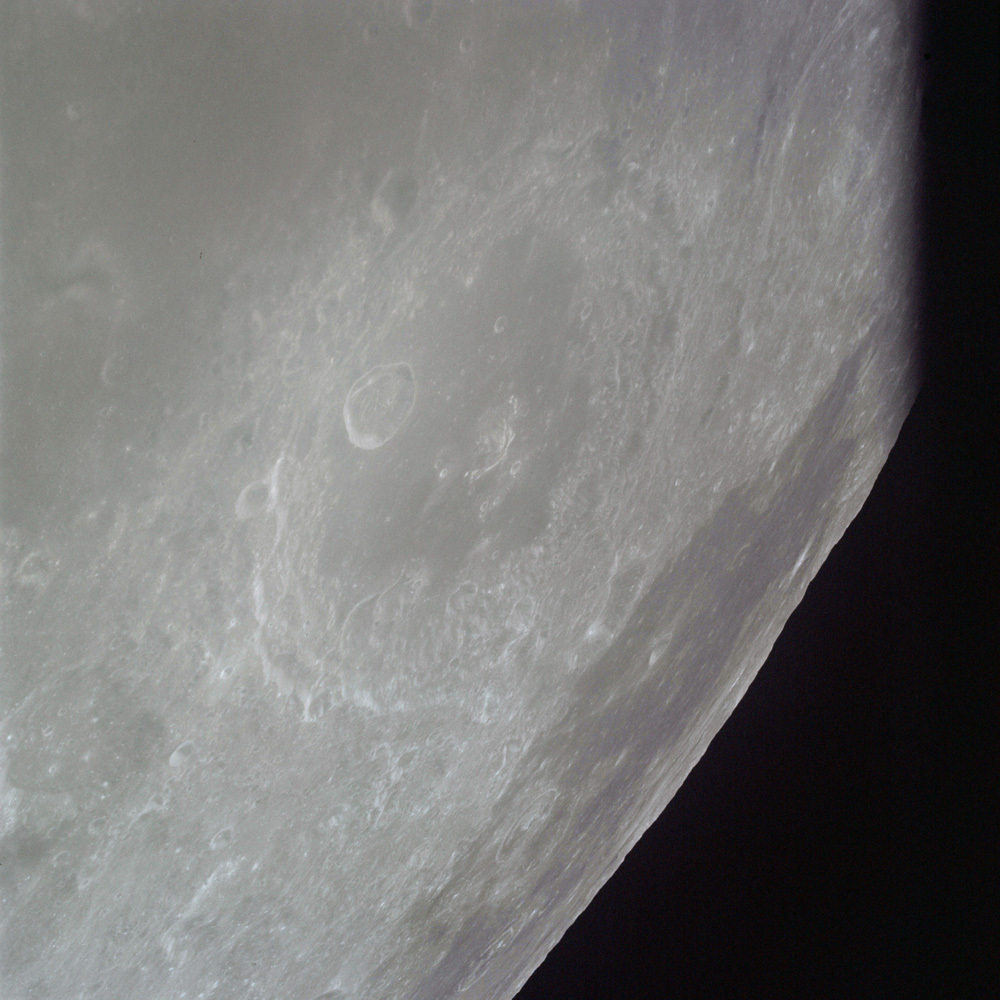
AS17-149-22786 - View south by southeast over Neper and Mare Smythii - JSC scan
089:28:32 Schmitt: Mark it. Power is On on the Pan Camera. Okay, Houston, we're waiting your cue on the power.
089:28:43 Fullerton: Okay on that, and there'll be no update to the TEI-4 PAD. Over.
089:28:51 Schmitt: Beautiful.
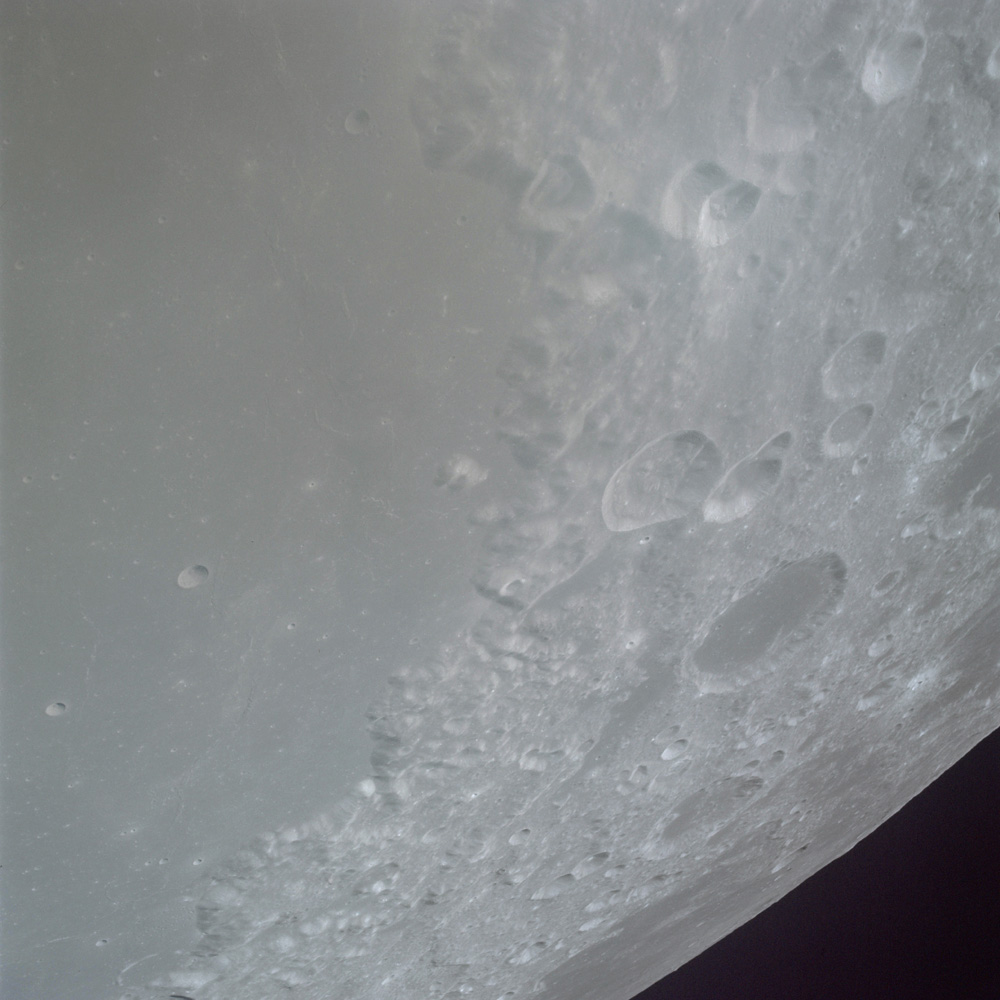
AS17-149-22787 - Southeastern rim of Mare Crisium, Auzout crater (right of centre) and Firmicus (dark-floored crater lower right of Auzout). Mare Fecunditatis on horizon - JSC scan
089:29:02 Schmitt: Here's Smythii, gang. Coming over Mare - No, let's see, Crisium. coming over Crisium. It's - coming underneath us now.
089:29:21 Schmitt: I will have in a jiffy. Okay, I'm going to hang off then a little bit. Get a - Boy, this window.
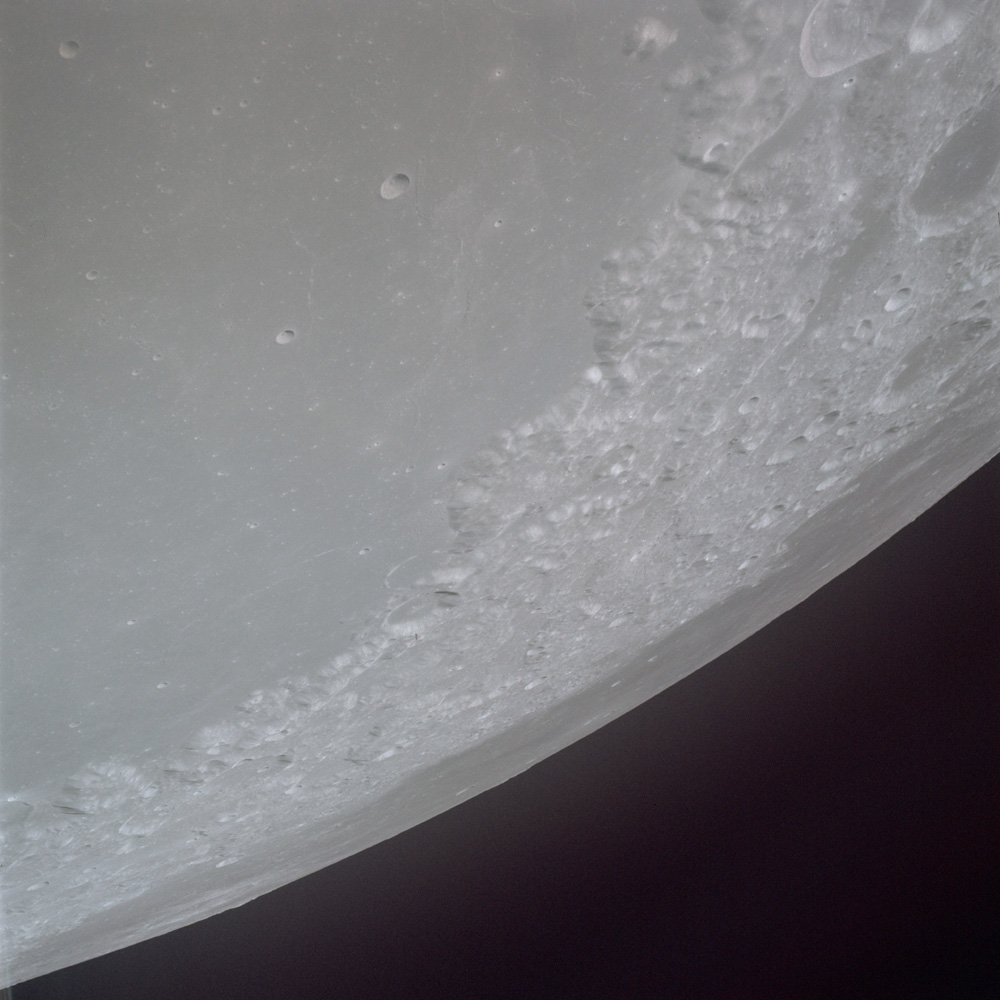
AS17-149-22788 - Southern rim of Mare Crisium. Mare Fecunditatis on horizon - JSC scan
089:29:44 Cernan: And, Gordo, how did the spacecraft look to you as we came around?
089:29:50 Fullerton: Real good, Geno. Nothing to report.
089:29:57 Cernan: Very fine. Thank you.
089:30:04 Schmitt: [Laughter.] One little minor problem, Gordy, is that we're breathing so hard that the windows are fogging up on the inside for a change.
089:30:24 Fullerton: Okay, and we'd like the Pan Camera Power, Off, now. The pan camera run; good.
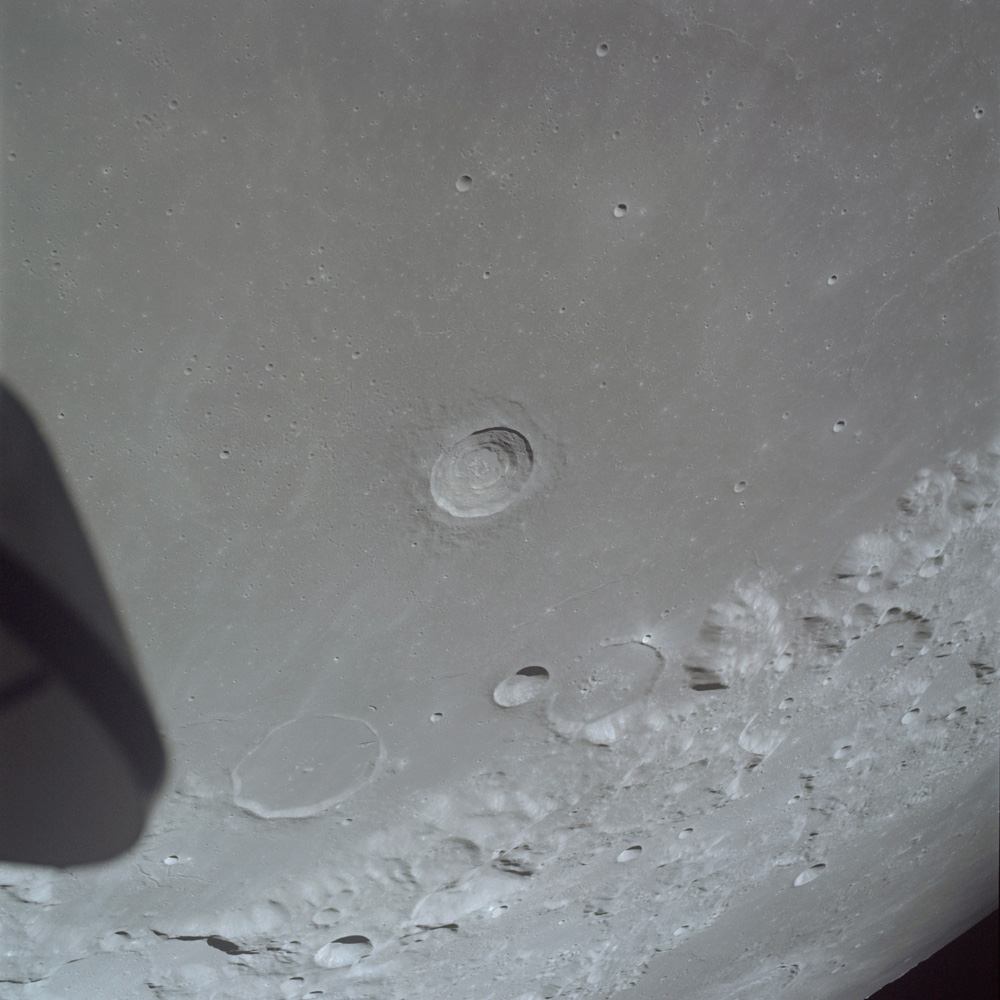
AS17-149-22789 - Southwestern rim of Mare Crisium. Crater Picard is centre of frame. Yerkes is flooded crater lower left next to rendezvous radar. Greaves and flooded crater Lick are lower centre - JSC scan
089:30:38 Cernan: Beautiful.
089:30:43 Schmitt: Oh, boy, there is Picard - or Peirce, one of the two.
089:31:00 Schmitt: Okay, Gordy, all those dark and light albedo changes around Picard and Peirce are not obvious at this particular angle yet. There's some hint of them.
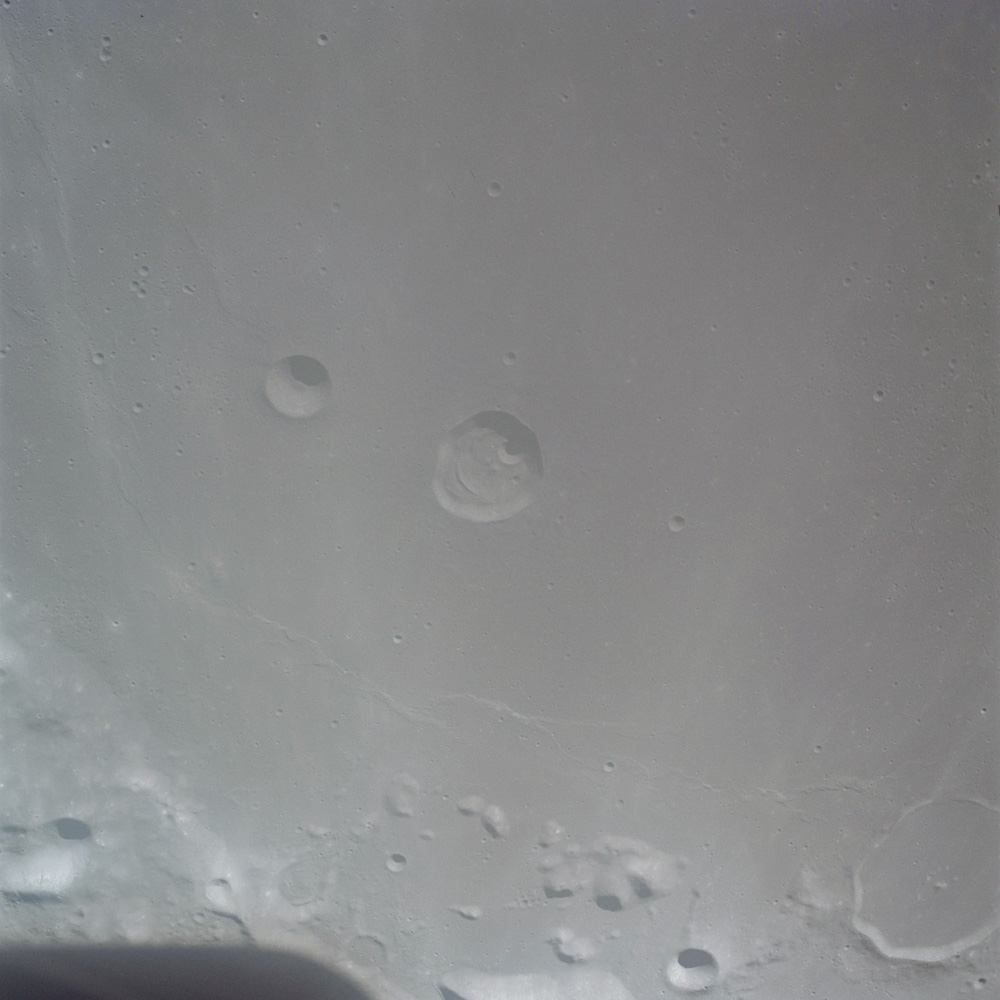
AS17-149-22790 - Western rim of Mare Crisium. Crater Peirce is centre of frame and Swift is smaller crater to its left - JSC scan
089:31:18 Fullerton: Roger.
089:31:21 Schmitt: The - rim - is there one farther south of Peirce?
089:31:29 Schmitt: Which - is it far - is the one farthest - Picard, yes.
089:31:38 Schmitt: Picard, I think, is the one I'm looking at. Yes, it is.
089:31:43 - Mark. 8 minutes to S-IVB impact.
089:31:46 Schmitt: Yes, and I can see Peirce now just - behind the rendezvous antenna - or radar. And - Yes, way out there, you ought to start seeing them.
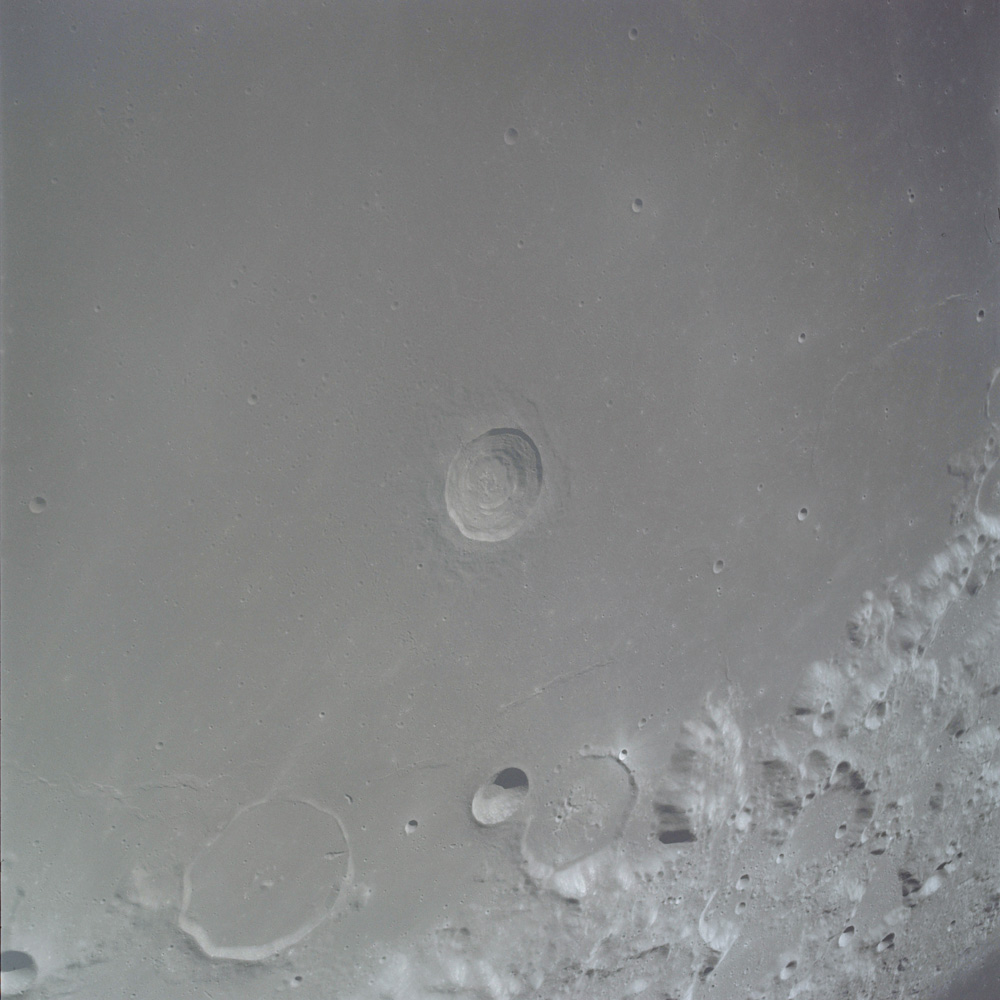
AS17-149-22791 - Southwestern rim of Mare Crisium. Crater Picard is centre of frame. Yerkes is flooded crater lower left. Greaves and flooded crater Lick are lower centre - JSC scan
089:32:02 Evans: I guess I ought to get that other stuff on the camera, huh?
089:32:09 Schmitt: Okay. We're just about over the top of Picard, and the rim materials, which go out about a third of a crater in diameter, as near as I can tell, are - are distinctly darker but not by much. They're more gray, really, then the gray-tan, or tannish gray of the rest of the mare.
089:32:33 Fullerton: Roger.
089:32:38 Fullerton: Now we assume you're all set up or about to get that way for the landing site photos.
089:32:46 Schmitt: Yes, sir. There is no obvious ray pattern or secondary pattern outside of that blanket around Picard.
089:33:07 Fullerton: Roger.
089:33:08 Schmitt: I see no loops or obvious alignment that would be related to that crater. There are blocks - look like great big blocky areas on the rim.
089:33:21 Fullerton: Roger.
089:33:28 - This is Apollo Control; some 6 minutes, 13 seconds away from S-IVB impact. The traces - seismograph traces - from Apollo 14 and Apollo 16 will be visible in the news room video monitors. There will be a briefing in the small briefing room on the seismology of the impact. Some 5 minutes, 43 seconds now away from S-IVB predicted impact.
089:34:08 Schmitt: Do they want the 80-millimeter lens on these terminators now?
089:34:32 Schmitt: There's Taruntius, Ron.
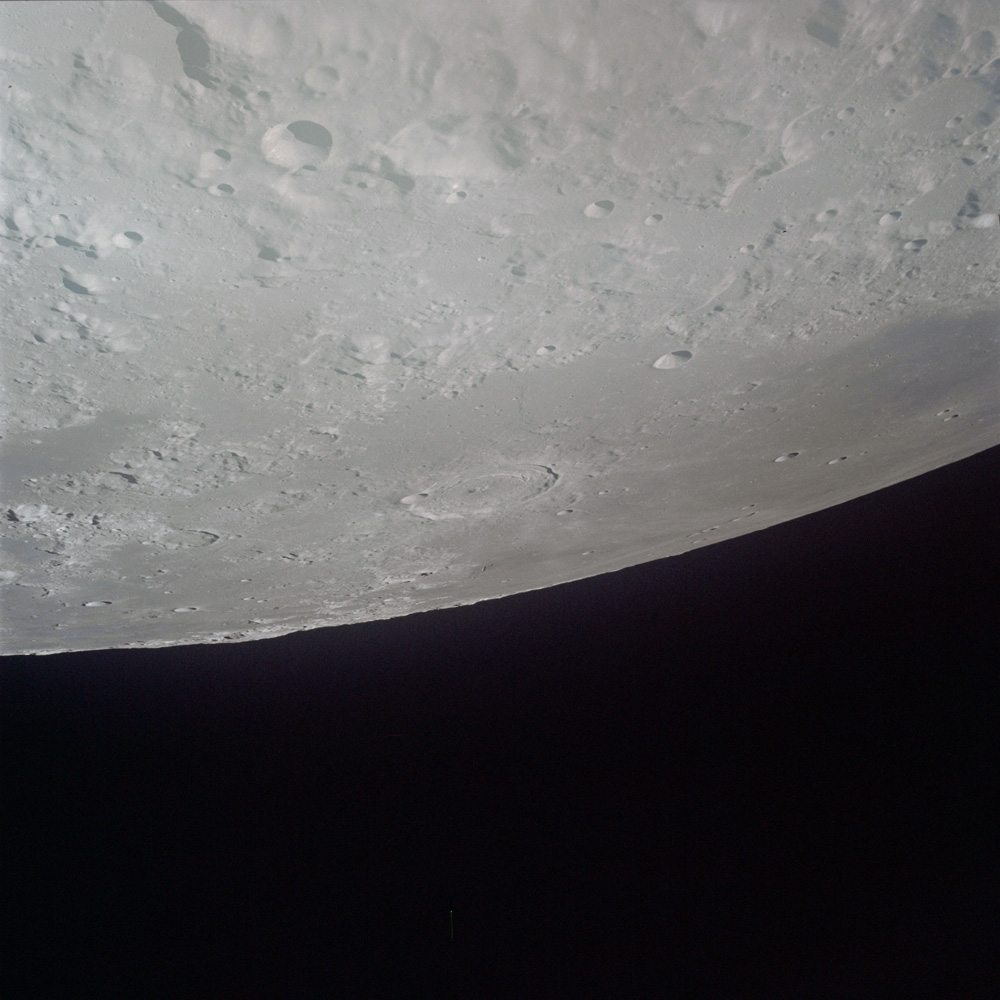
AS17-149-22792 - View south to Mare Fecunditatis. Large crater Taruntius is centre of frame - JSC scan
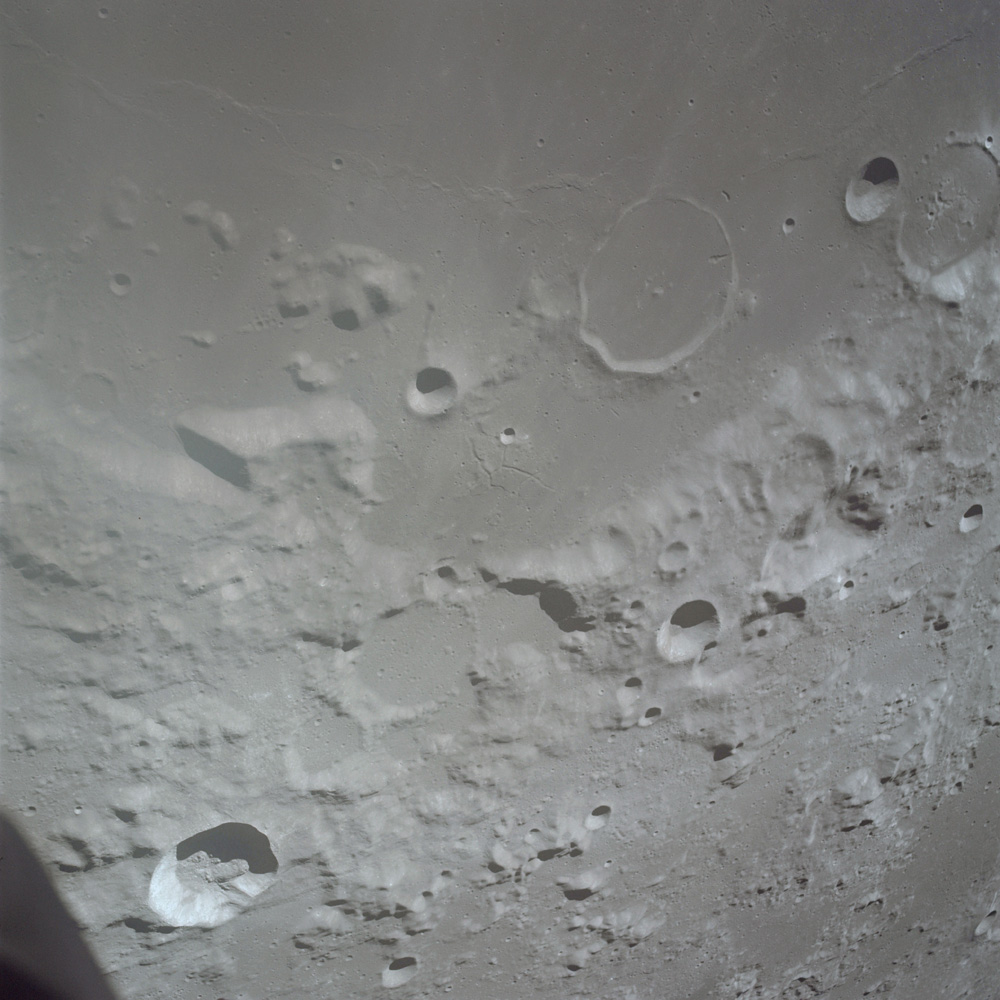
AS17-149-22793 - Western rim of Mare Crisium. Yerkes is flooded crater upper right of centre, Lick is cut off on extreme upper right. Proclus is prominent crater lower left. Glaisher is lower right - JSC scan
089:34:37 Schmitt: Yes, I guess that's right.
089:34:58 Schmitt: I've got to get another magazine on it.
089:35:11 Fullerton: America, can you verify the position of the P - PU valve at this time for us?
089:35:18 Cernan: Roger. It's in Normal.
089:35:21 Fullerton: Okay.
089:35:44 Schmitt: Macrobius, Macrobius, my friend.
089:35:46 Cernan: No, it's Microbus [sic].
089:35:57 Schmitt: Okay, I'm loaded up for your terminator, Ron. What's - is it not out of 105, or what? is it - Okay, 80-millimeter or...
089:36:15 Evans: [Garble] Millimeter [garble] f/11 at 1/500 [garble]
089:36:19 Evans: 80-millimeter.
089:36:22 Evans: f/11 at 1/500.
089:36:23 Schmitt: Five frames over the terminator, huh?
089:36:25 Evans: 12 frames.
089:36:26 Schmitt: 12 frames. Very good. How soon do I start?
089:36:29 Evans: Well, about...
089:36:36 Schmitt: Okay, in about 5 minutes, all right.
089:36:39 Schmitt: Gordy, you'd be interested - there's a crater that just on - on the west rim of Crisium. Relatively fresh rim - fairly crisp rim - but no strong ray pattern. There's no ray pattern apparent at all. It looks like it's pre - the plains material around it - that - since they come right up over the - right up to the edge of the crater in one spot. That is Posidonius. That's right. That's what I'm looking at.
089:37:20 Fullerton: Roger.
089:37:26 Schmitt: Not Posidonius, Proclus. That's what I'm describing. You know I - You're looking where?
089:37:36 Cernan: [Garble] 41.
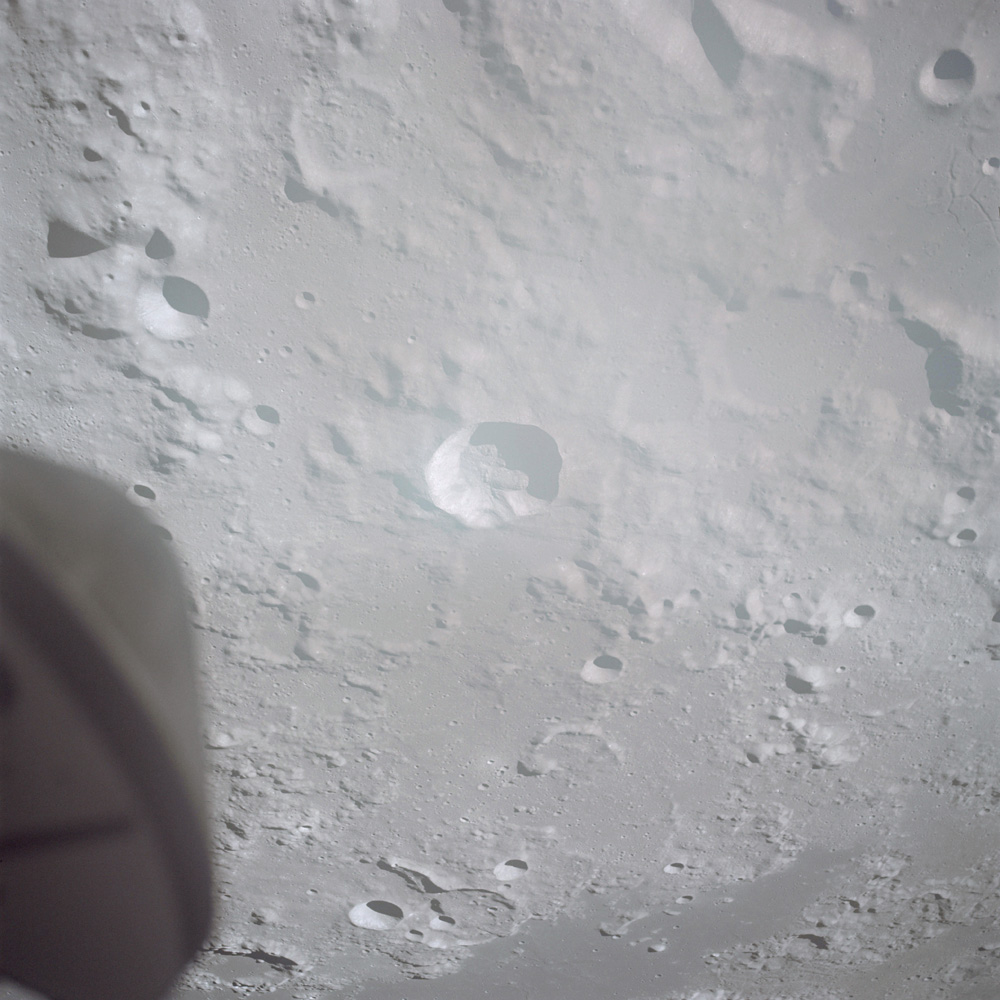
AS17-149-22794 - Crater Proclus in centre of frame - JSC scan
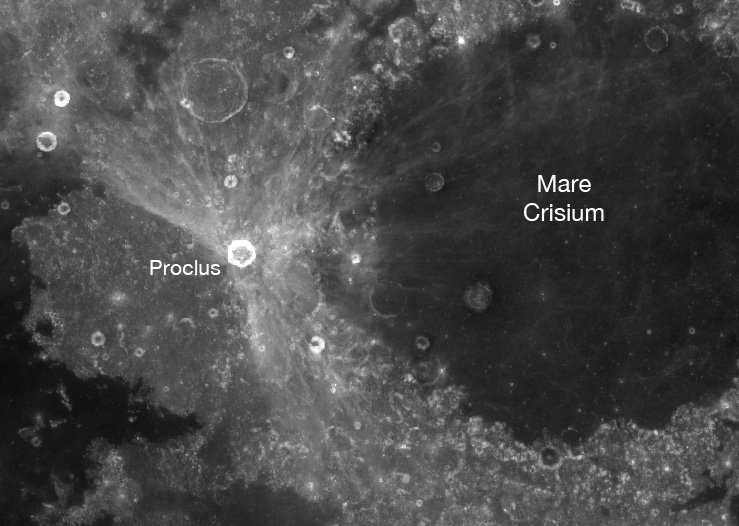
Image from Lunar Reconnaissance Orbiter with high-angle illumination showing Proclus and its excluded ray system. (NASA/ASU)
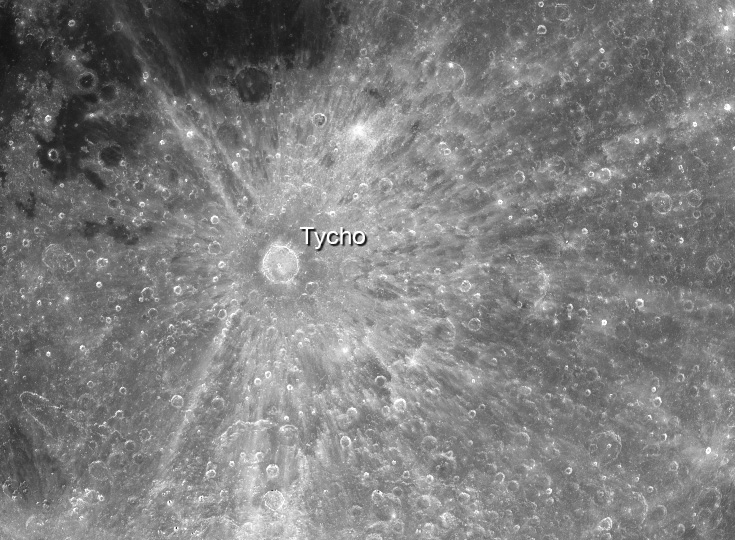
Image from Lunar Reconnaissance Orbiter with high-angle illumination showing Tycho and its asymmetric ray system. (NASA/ASU)
089:37:38 Schmitt: Infamous Proclus. Okay, give me a mark when I'm - Hey, look at the...
089:37:50 Cernan: Okay, I'll give you a mark, Jack.
089:37:51 Schmitt: At the Cauchy Rilles here. Man, is that neat. Let me see. Going to have to...
089:38:06 Cernan: One right there with the shadowed peak in there. Right? Yes, yes, yes, yes, yes. And that's out of this window, huh? I'm not - sure I'm seeing it yet.
089:38:40 Schmitt: Manischewitz! Look at those terminators.
089:38:42 Cernan: Shadows.
089:38:44 - One minute Mark to the S-IVB impact.
089:38:49 Schmitt: There's the mare domes for the central craters. They're certainly obvious. In - northern part of - Let's see...
089:39:05 Cernan: The lineations that trend to the northwest through this entire - entire section - they go through the - mostly through the highlands.
089:39:21 Schmitt: I can get the pictures. Is it directly out of window 5? Okay. We've got about another minute and a half. I'm going to proceed here at 41.
089:39:32 Evans: It'll be right underneath the groundtrack. It's right under it.
089:39:35 Schmitt: Well, that's the way we're going. I'm taking them east-west.
089:39:38 Evans: Okay. I [garble]
089:39:40 Schmitt: O - yes. Okay.
089:39:49 Cernan: Hey, Jack, we're at - coming up on 40.
089:40:03 - We had Loss Of Signal right on-time with the Instrument Unit of the Saturn IVB which...
089:40:07 Fullerton: [Garble] about a minute to PRO on P20.
089:40:09 Cernan: Yes. We're at 40 - Okay, I'm with you, Gordo. Thank you.
089:40:27 - Seismic signals beginning to come in.
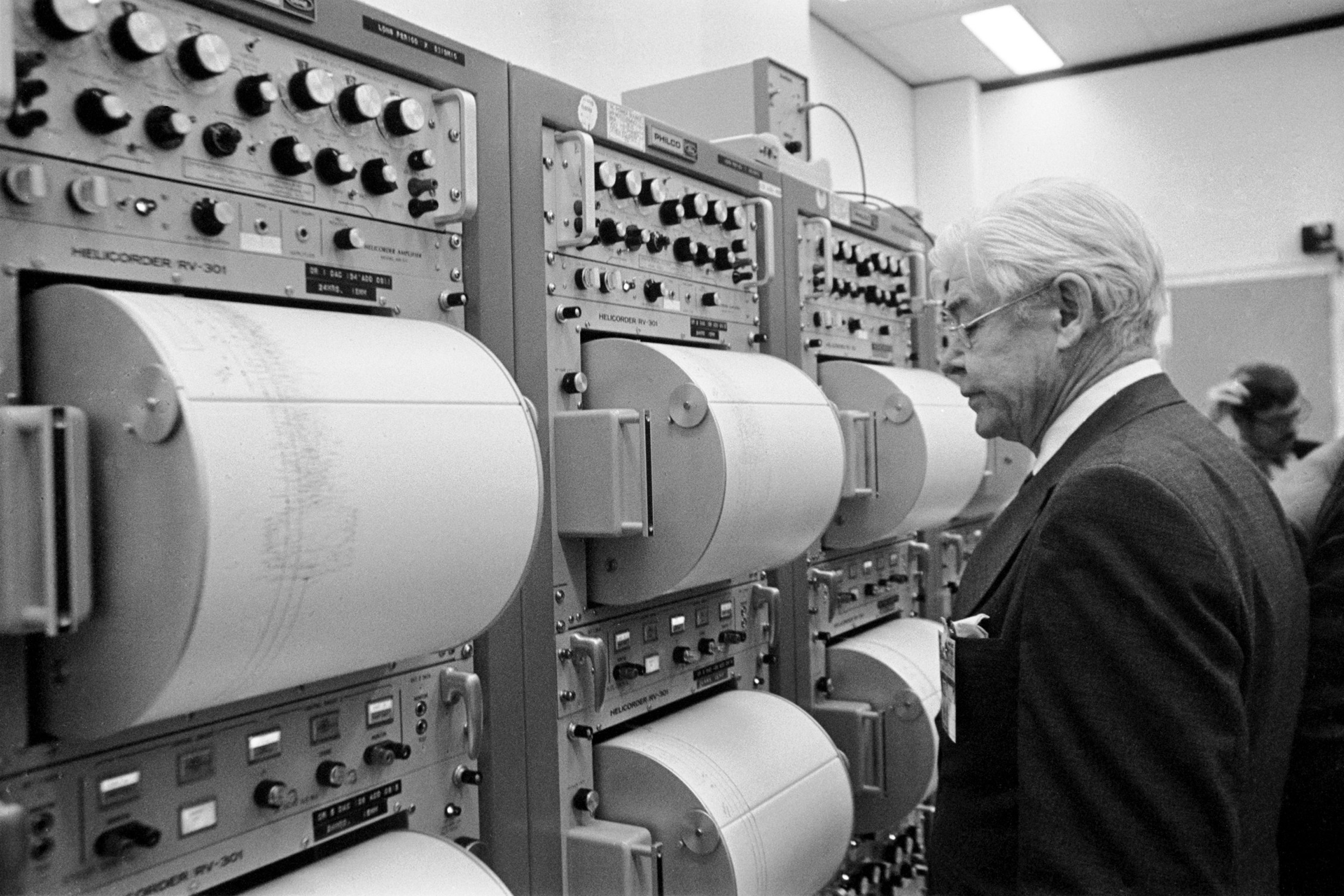
Seismologist Maurice Ewing examining data from the Passive Seismic Experiment (PSE) - research: Eric Jones
089:40:30 Evans: Okay, you got it.
089:40:52 Cernan: Don't forget to Pro, Ron; you've got - you got 8 seconds.
089:41:01 Cernan: Mark it - 41. Okay, I guess you can.
089:41:08 Evans: Goes. With the usual FAO flight planning, that was a good time.
089:41:17 Fullerton: Roger.
089:41:18 Evans: Hey, you can even see horizon in the - Earthshine out there.
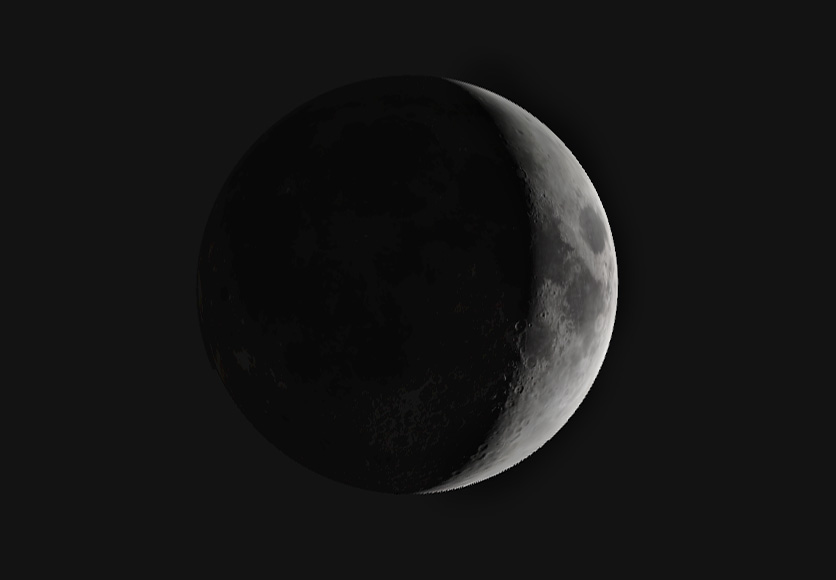
Simulated image of the Moon to replicate how it would have appeared as seen from Earth on 10 December 1972. (Stellarium)
089:41:26 Cernan: Boy, you sure can. You can see an Earthlit horizon out there into the dark part of the Moon.
089:41:34 Evans: Can you see the landing site? I think it's going to be in the darkness.
089:41:37 Cernan: You know, I - it - The shadows are so contrasting here, Ron, that I...
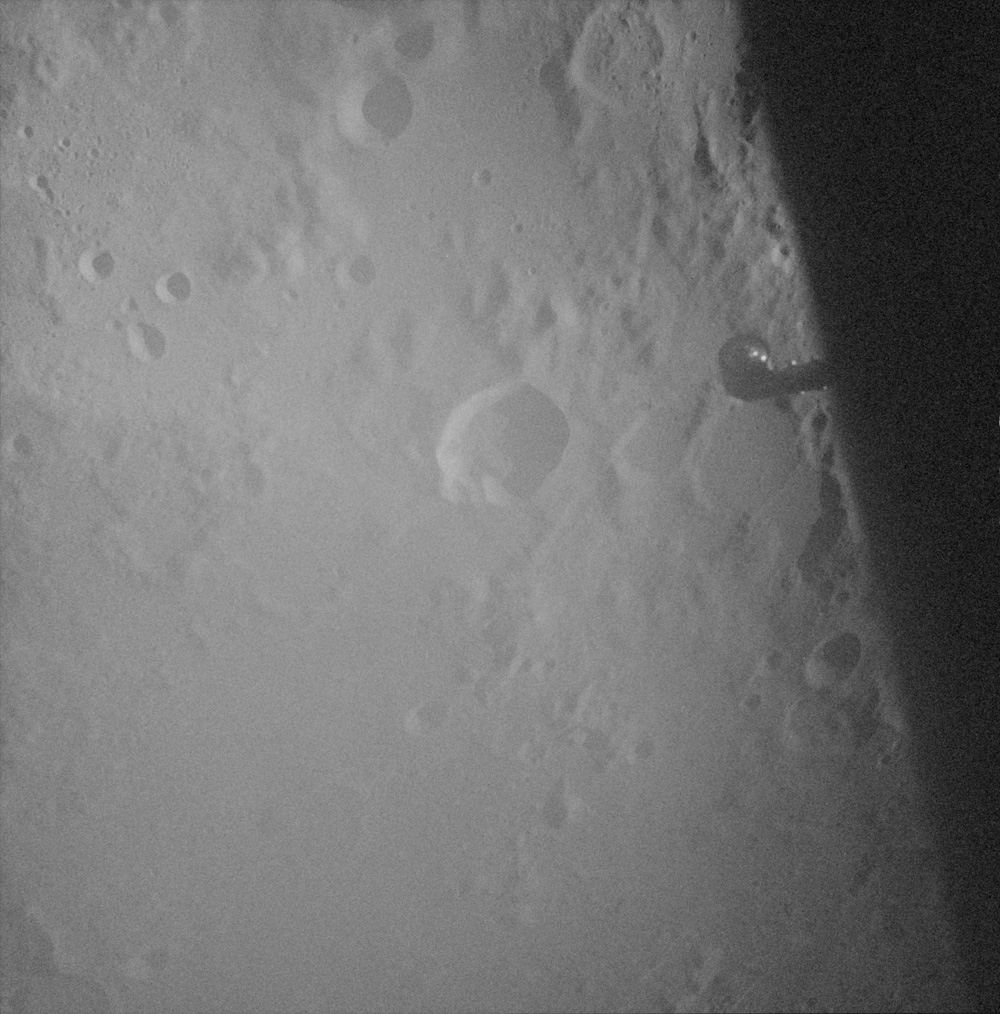
AS17-154-23599 - Proclus, P, R, S, U, Glaisher, E, W - NARA archives
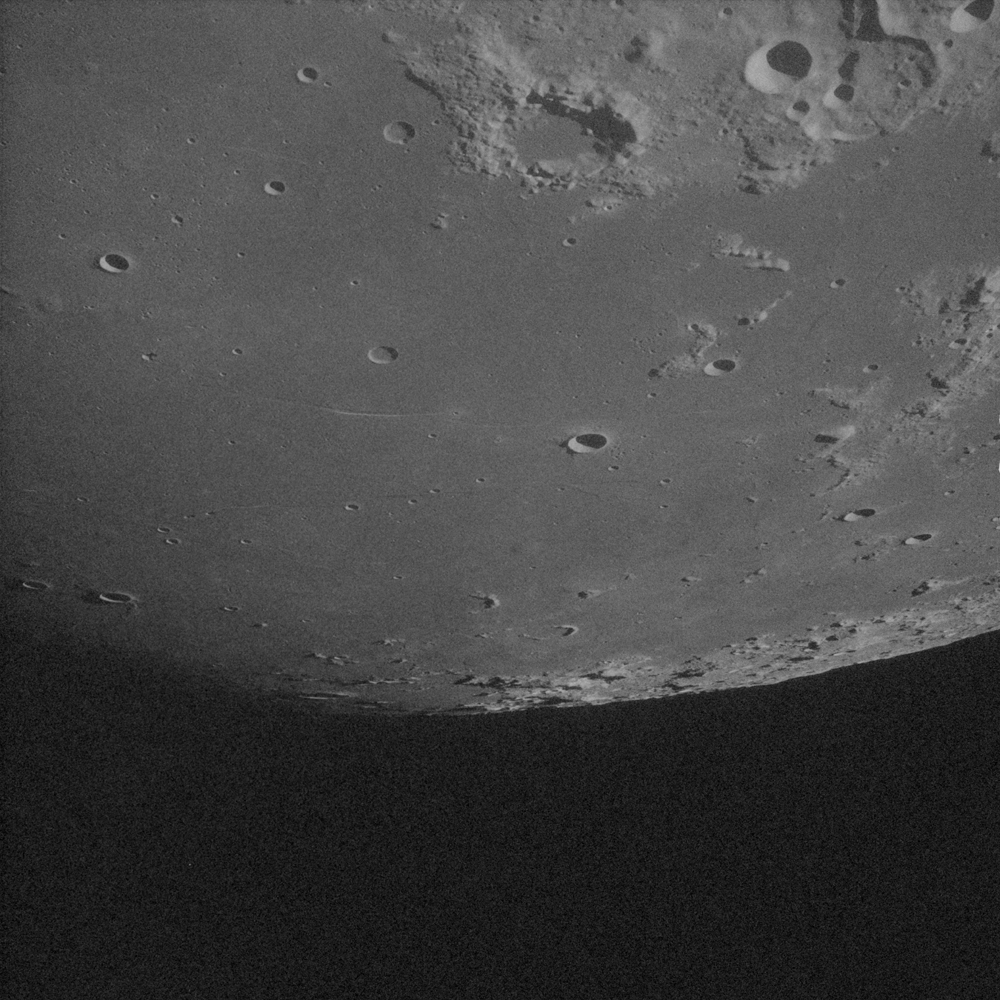
AS17-154-23600 - Cauchy A, B - NARA archives
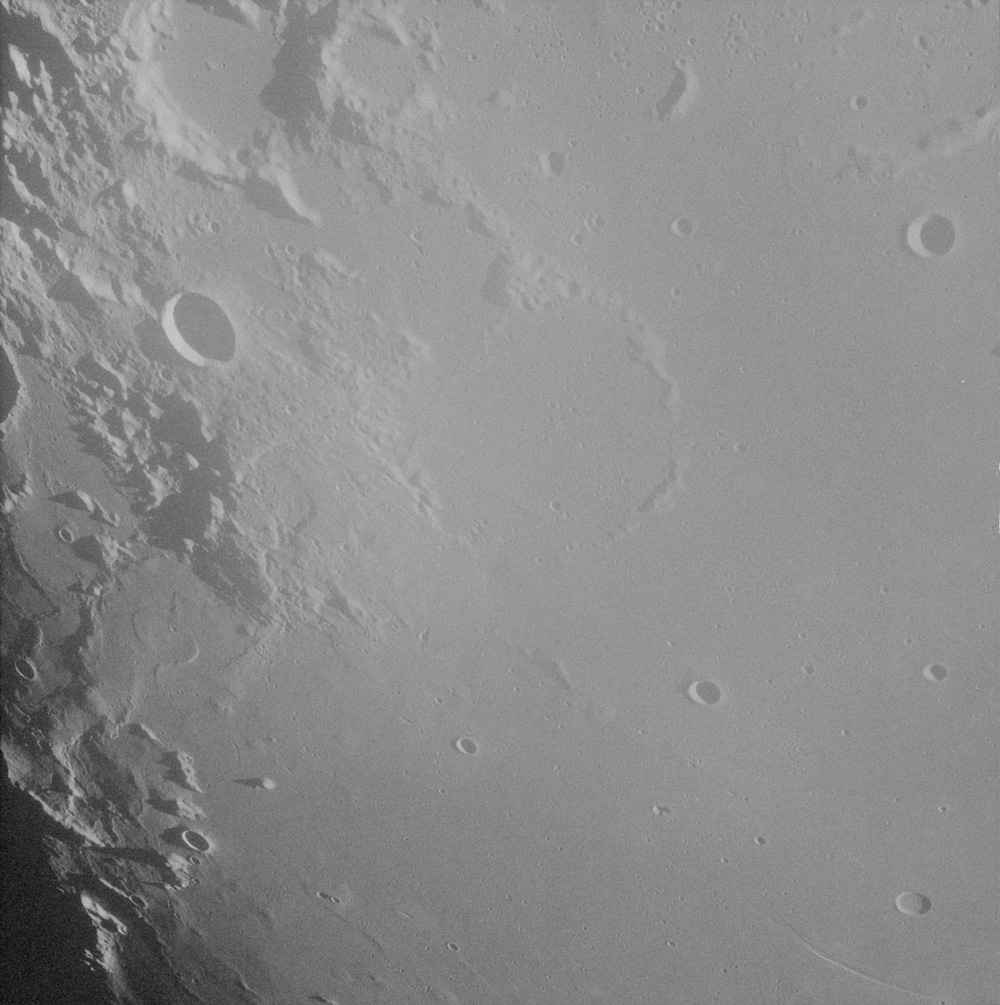
AS17-154-23601 - Maraldi, D, E, R, Vitruvius A, H - NARA archives
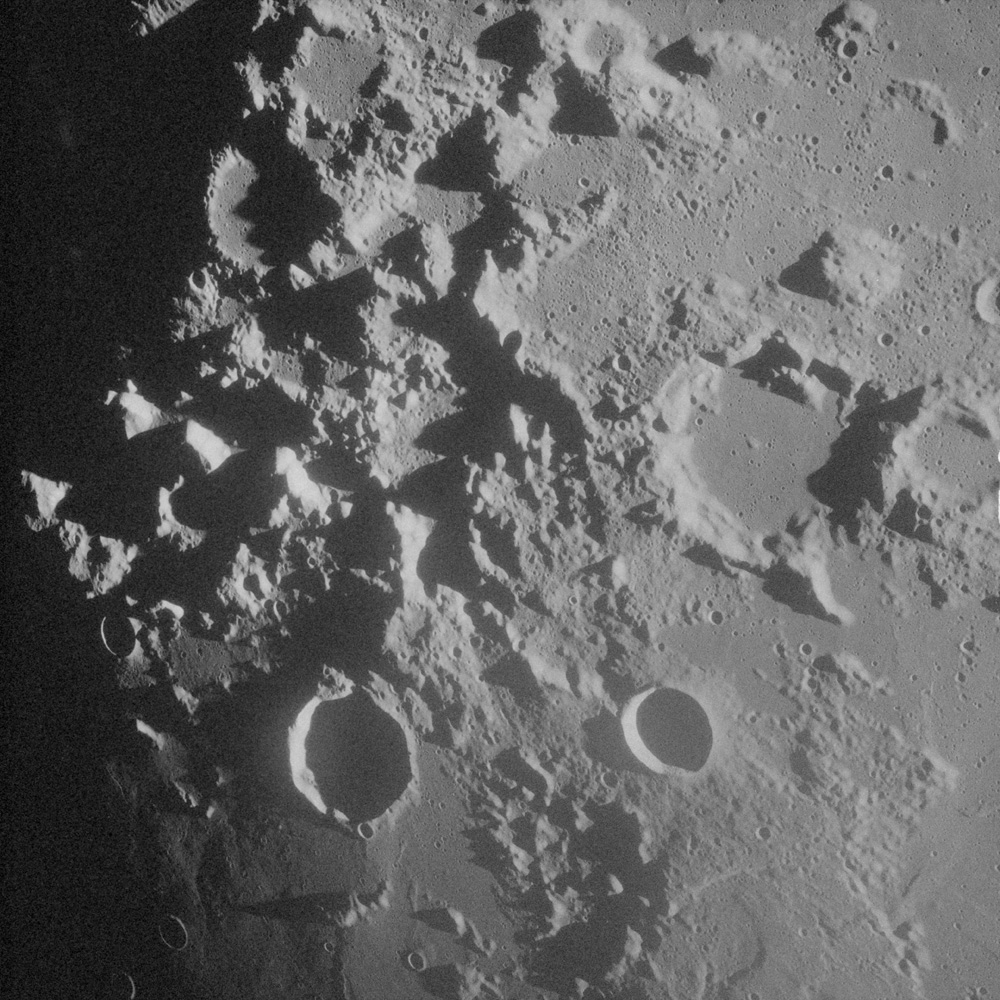
AS17-154-23602 - Maraldi, Vitruvius, Littrow - NARA archives
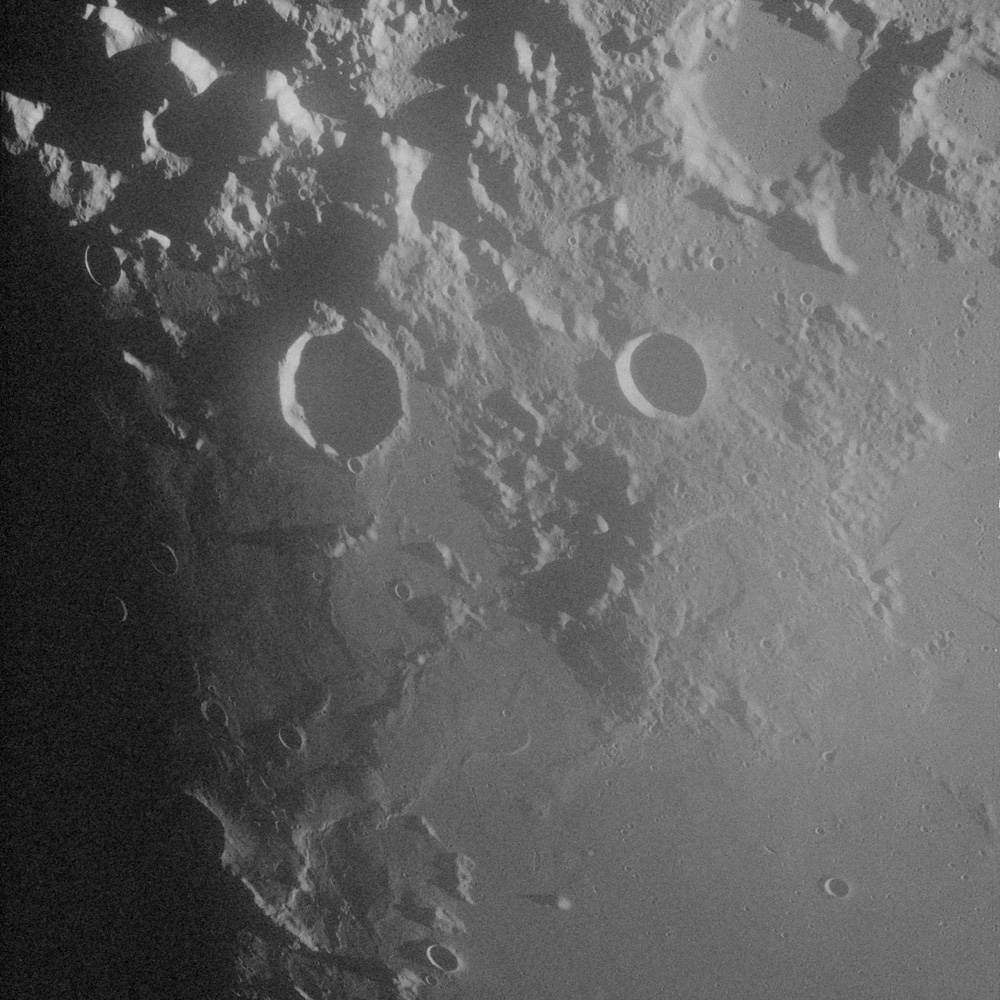
AS17-154-23603 - Maraldi, E, Vitruvius, A, B, C, H - NARA archives
089:41:44 Cernan: Give me that thing a minute.
089:41:59 Schmitt: [Posi]donius. There's le Monnier, the landing site. I can't...
089:42:08 Cernan: No, it's just - it's just dark.
089:42:09 Schmitt: Isn't it a little north of track?
089:42:12 Cernan: No, I think it's right below us, Jack. I think it's right smack below us.
089:42:16 Schmitt: In darkness...
089:42:17 Cernan: Yes, I yes, it is. I can't - I think I'm looking at Littrow right there, right below us. But I can't quite tell.
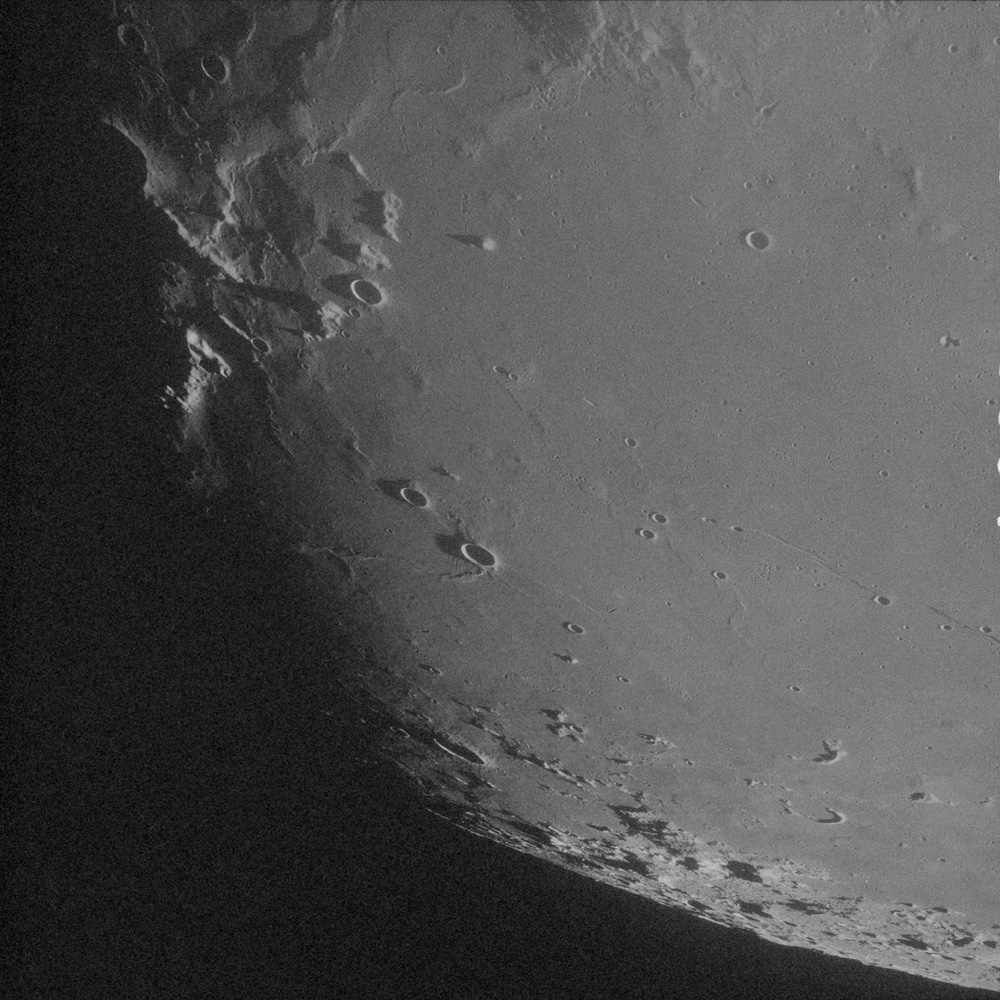
AS17-154-23604 - Sinas - NARA archives
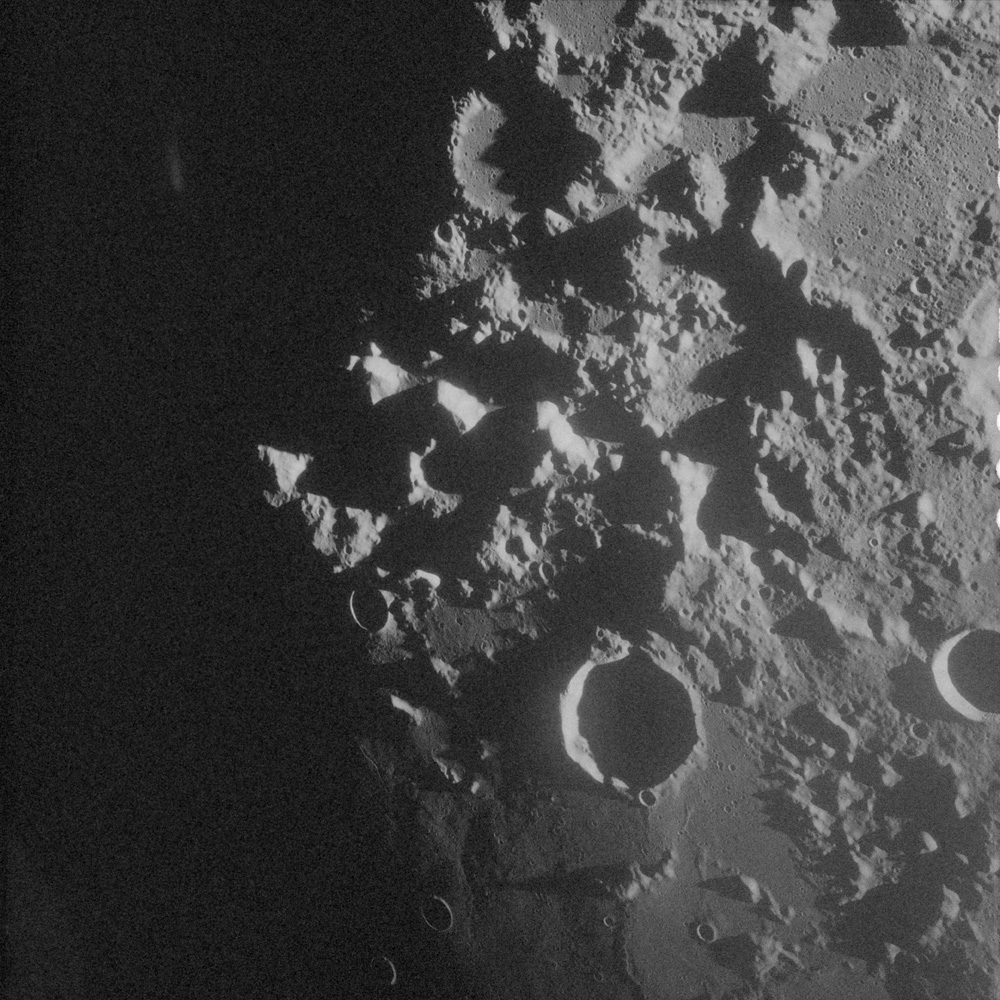
AS17-154-23605 - Littrow, Vitruvius, A, B, L - NARA archives
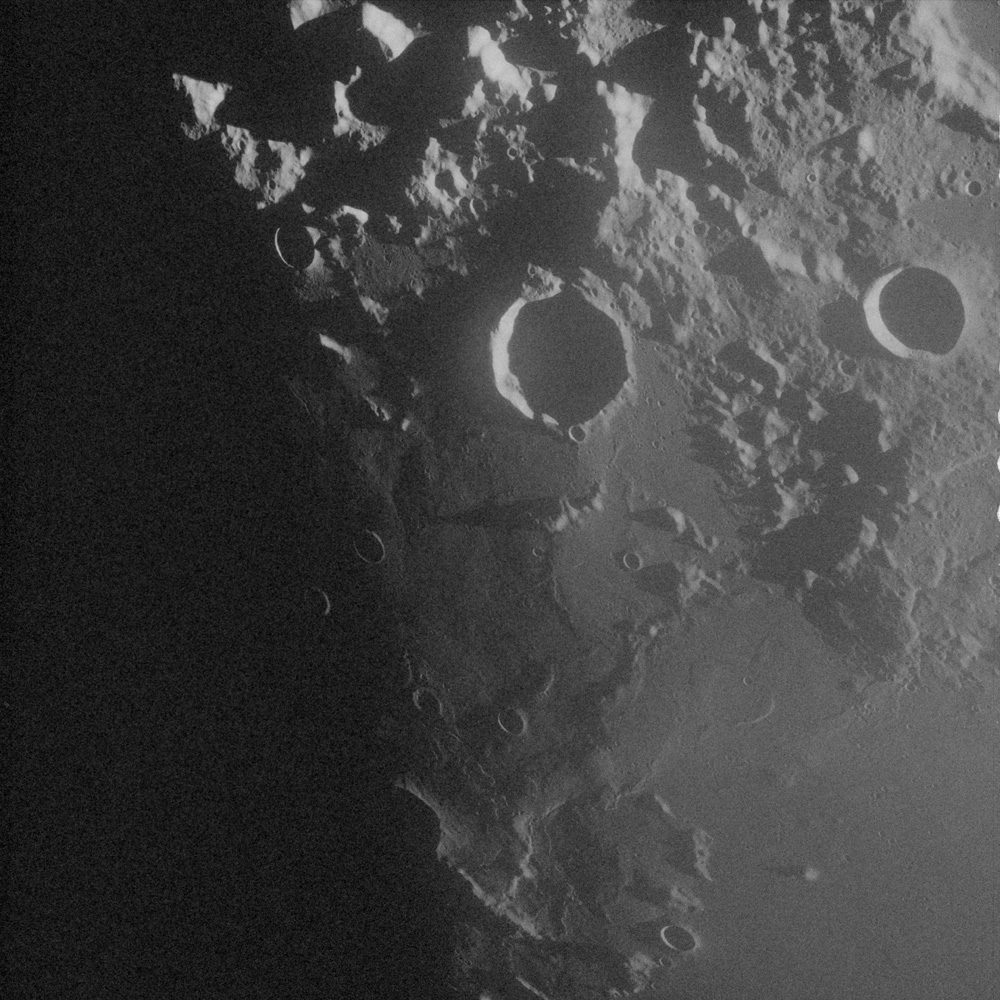
AS17-154-23606 - Vitruvius, A, B, Jansen F, L - NARA archives

AS17-154-23607 - Jansen F, T - NARA archives
089:42:31 Cernan: If I could see Vitruvius, I'd have a better handle on it.
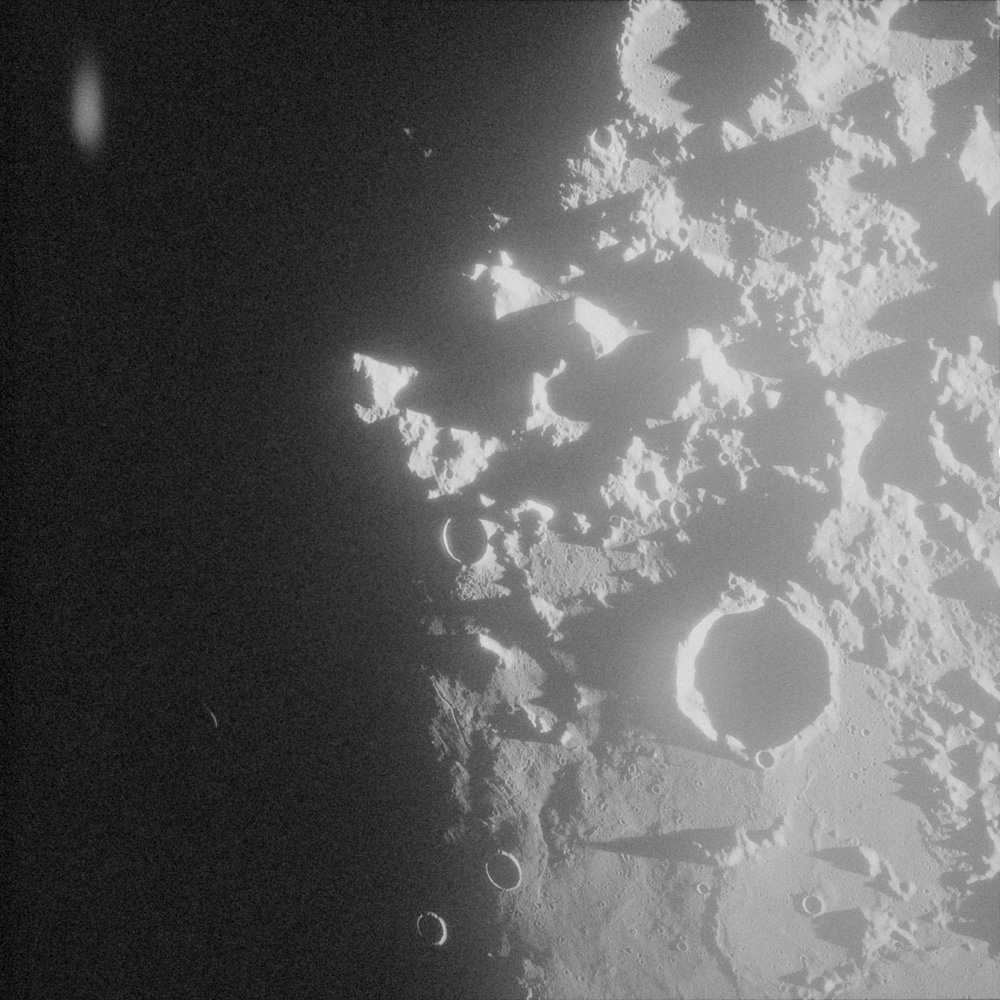
AS17-154-23608 - Vitruvius, Littrow - NARA archives
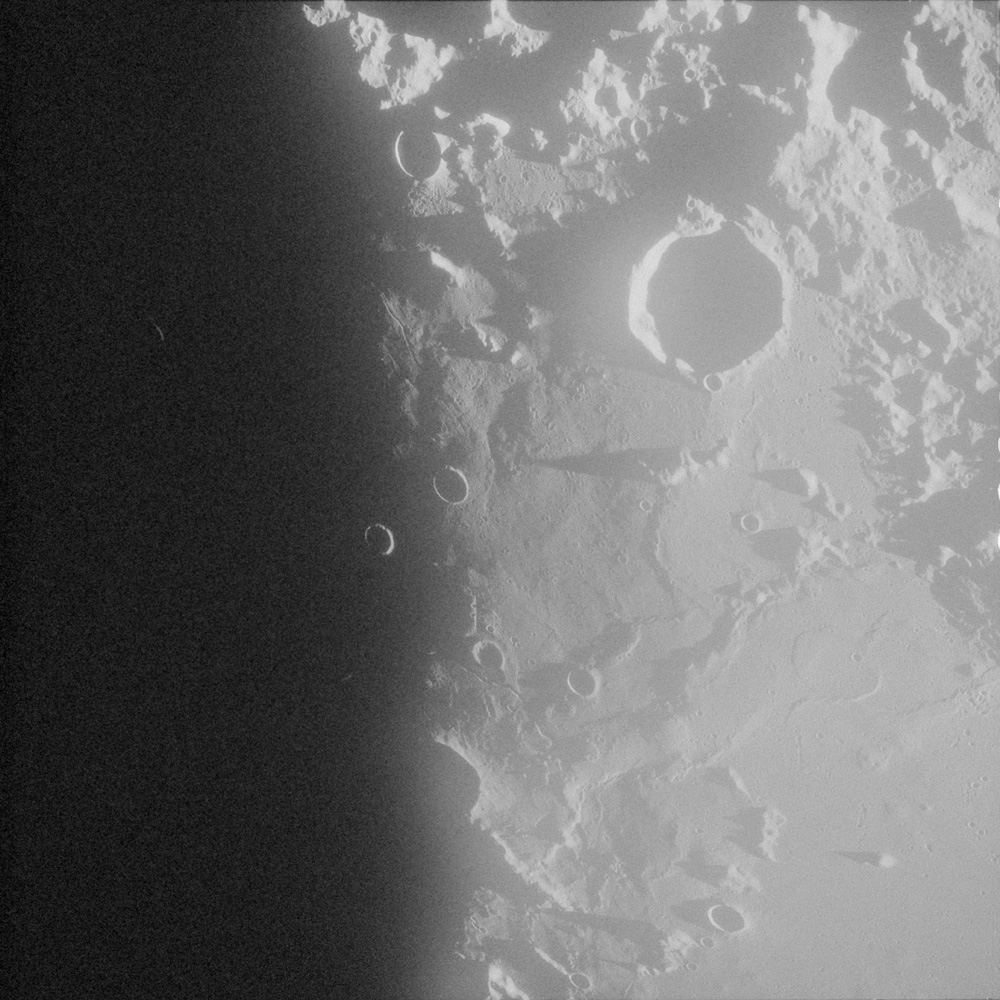
AS17-154-23609 - Vitruvius, B, Jansen F, L - NARA archives
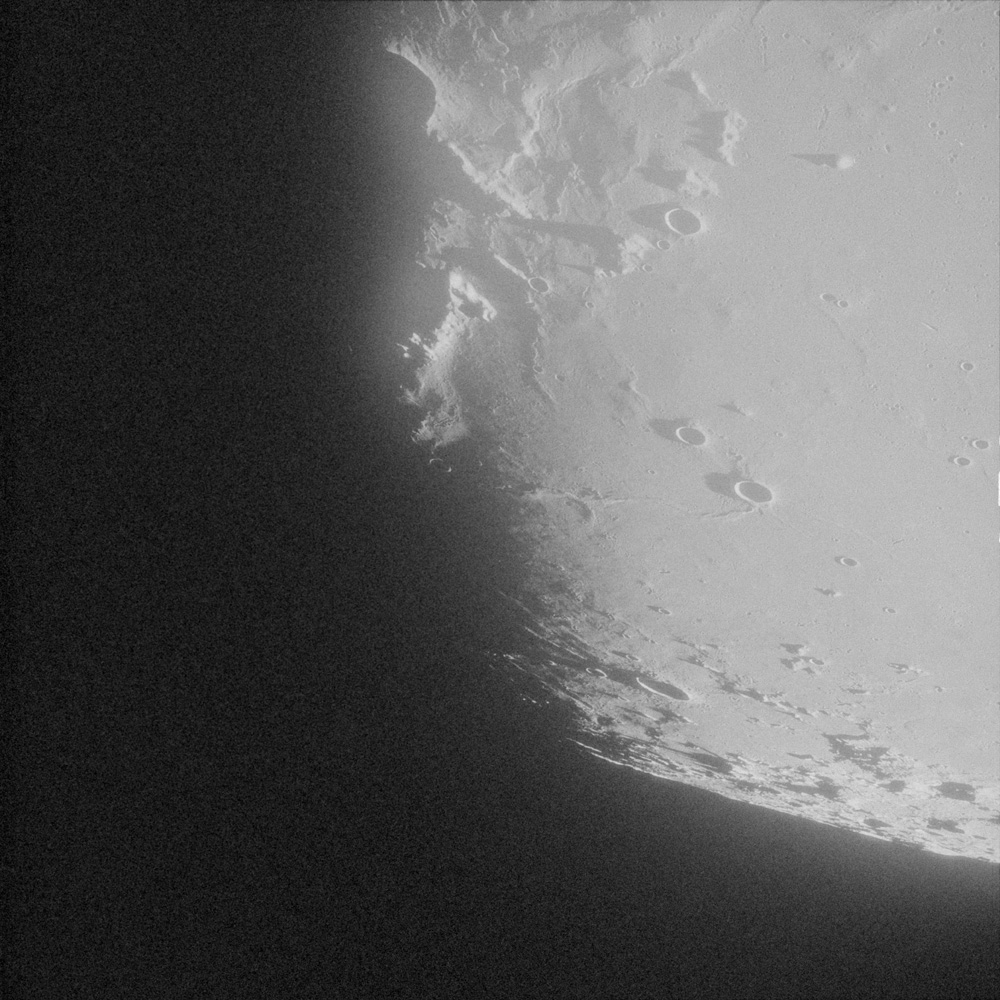
AS17-154-23610 - Sinas, A, E - NARA archives
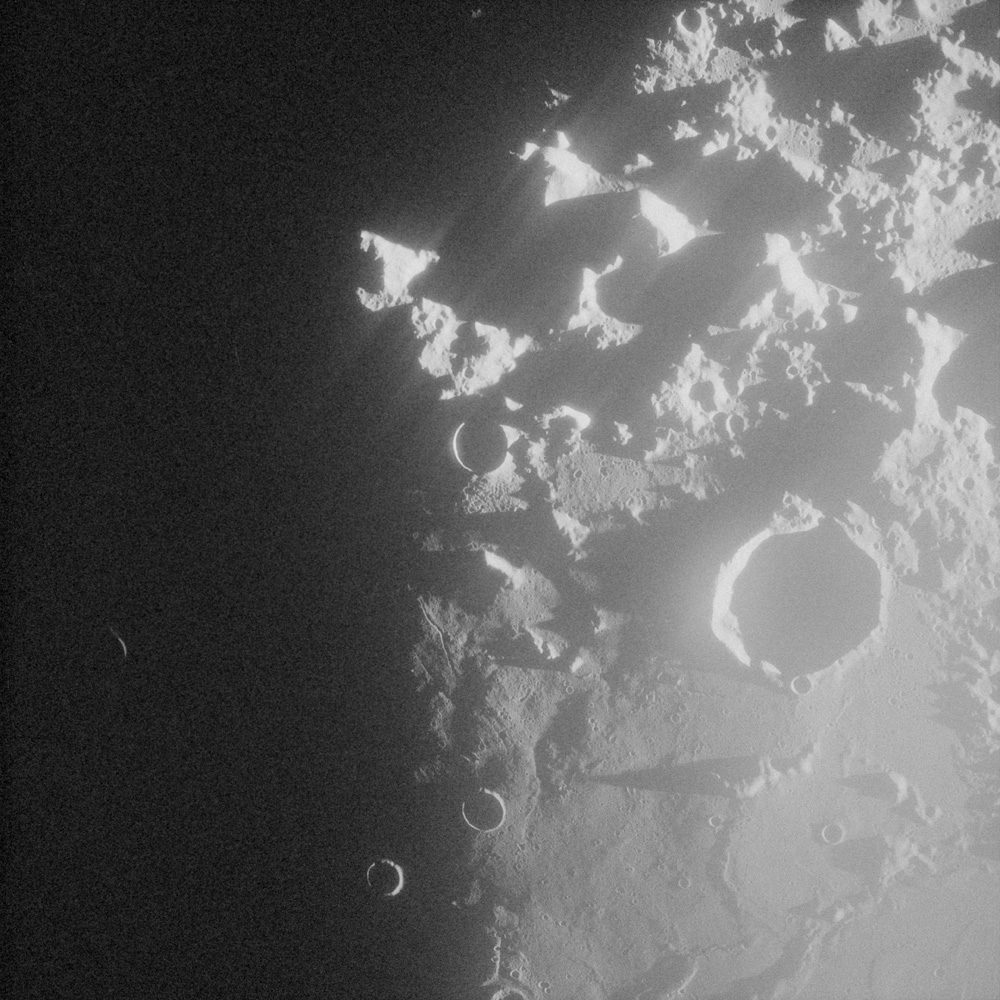
AS17-154-23611 - Vitruvius, L - NARA archives
089:42:36 Fullerton: A reminder to go to f/4 and 1/250 on the last six pictures.
089:42:44 Cernan: Roger. That's Posidonius all right, le Monnier; we're here early.
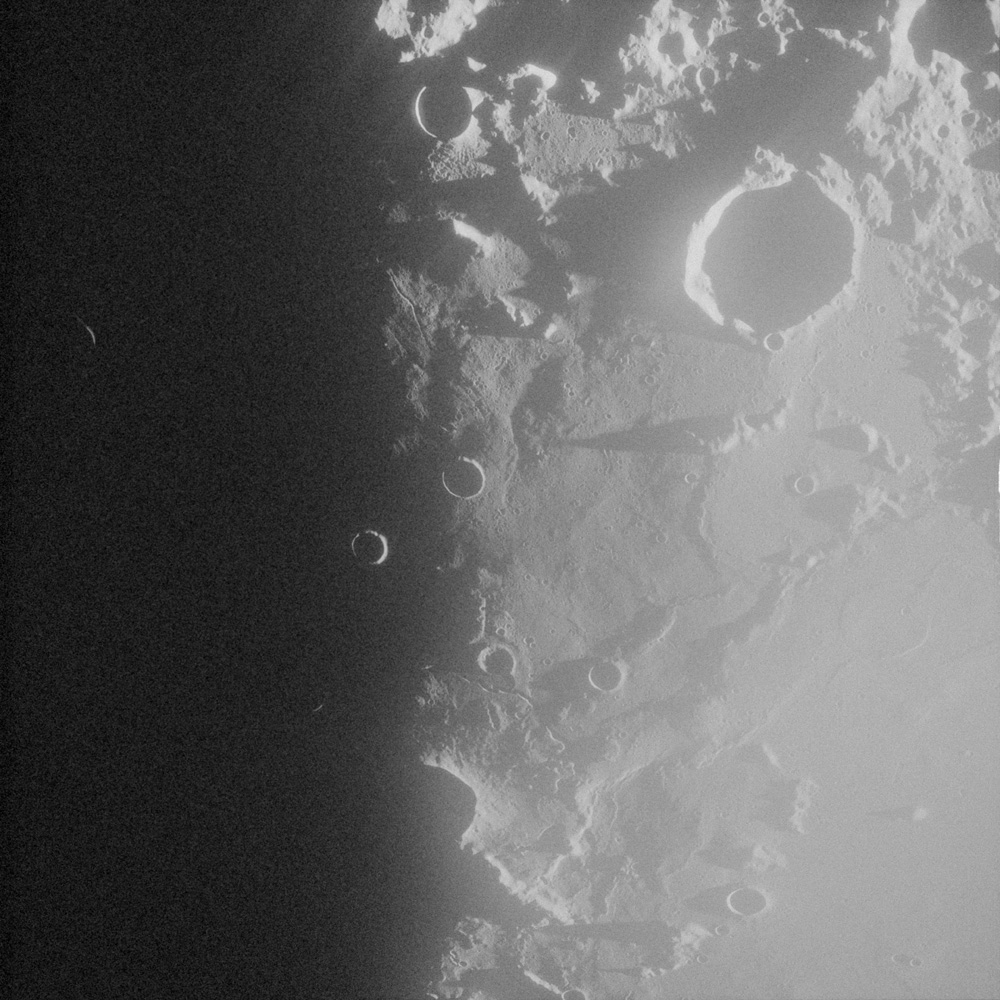
AS17-154-23612 - Vitruvius, Jansen C, L - NARA archives
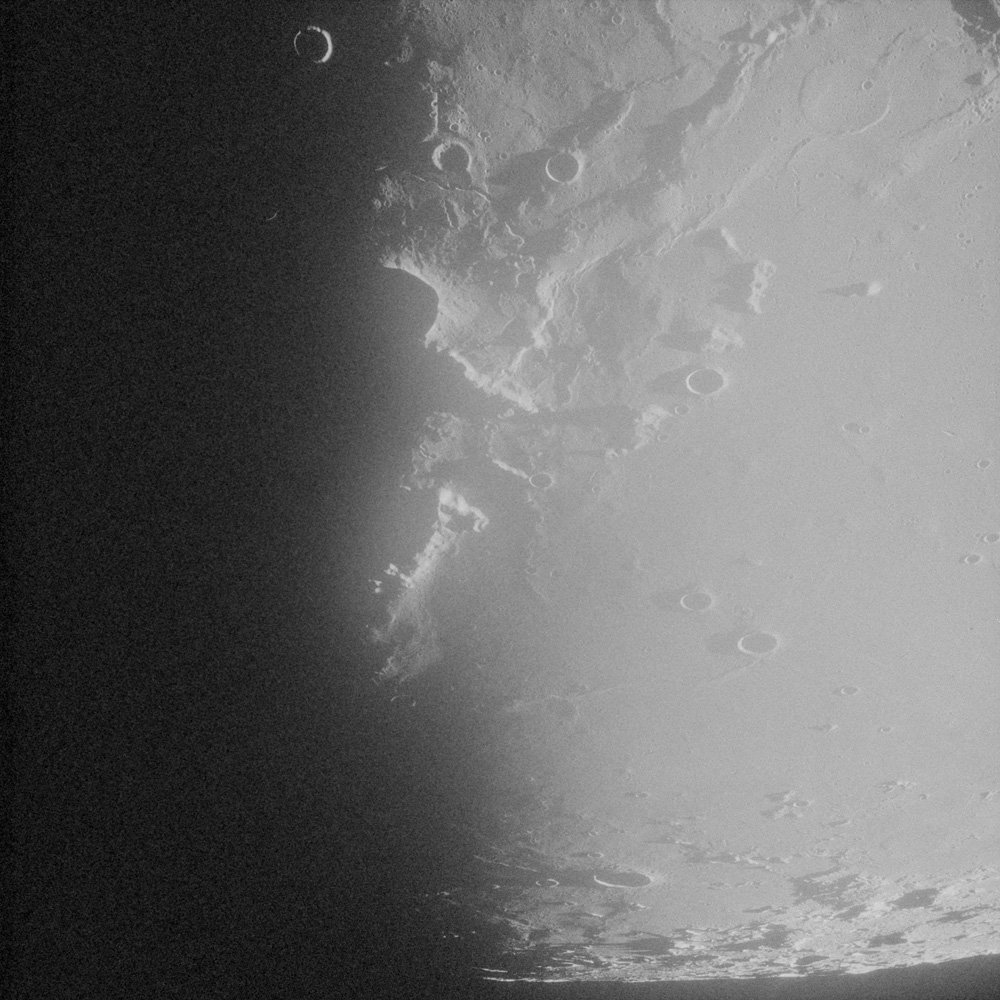
AS17-154-23613 - Jansen F, L, Sinas - NARA archives
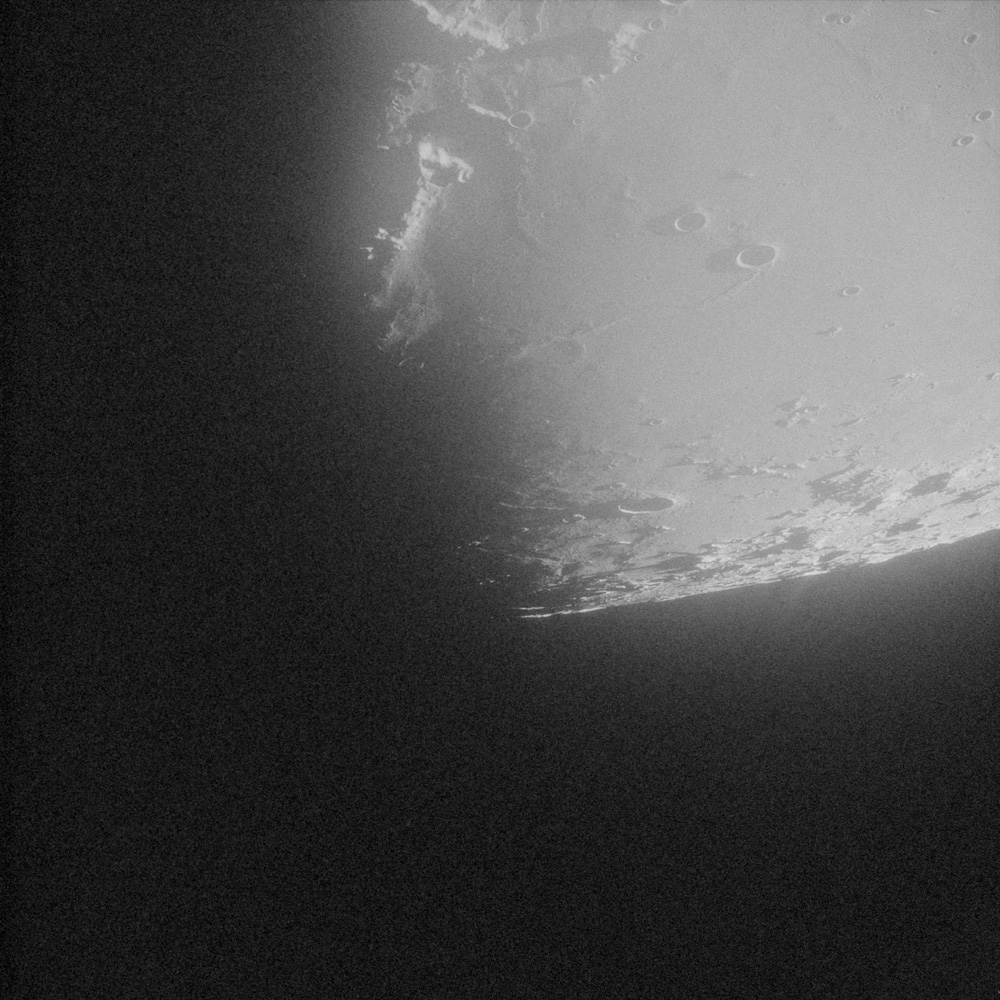
AS17-154-23614 - Maskelyne, N, R - NARA archives
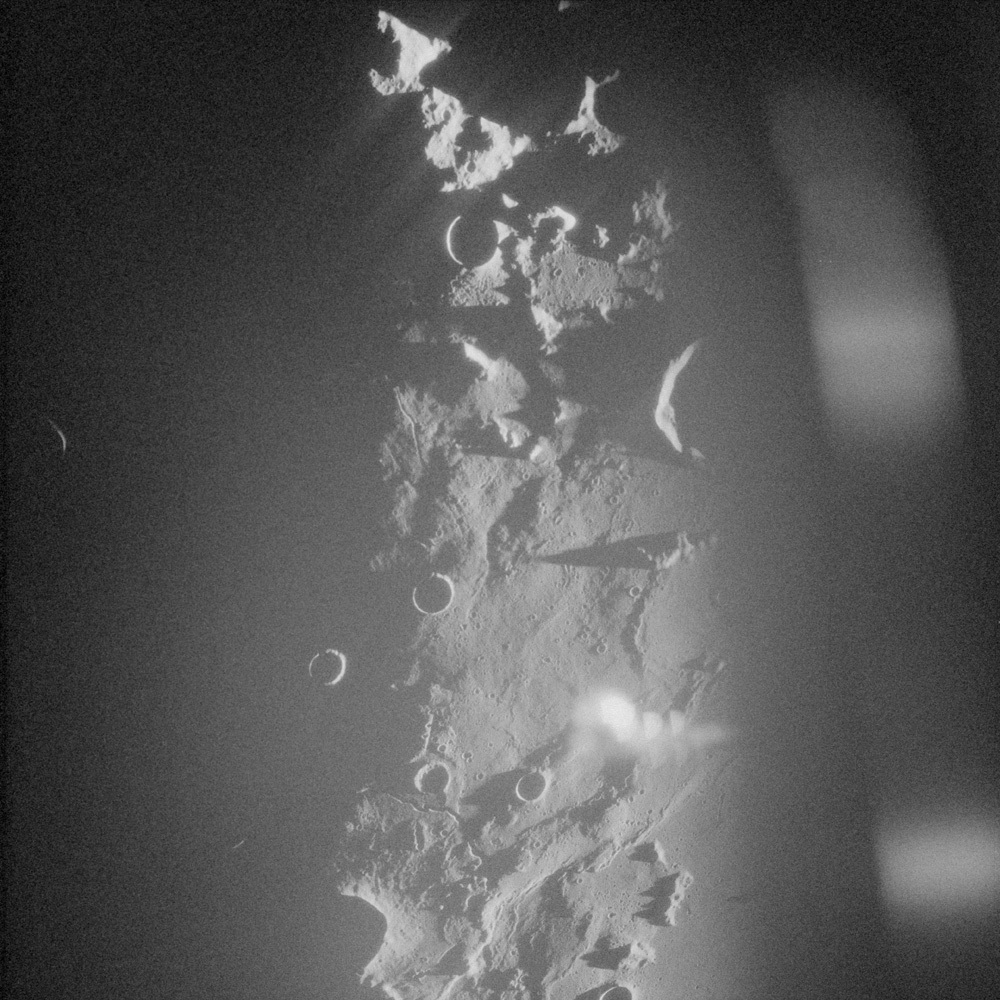
AS17-154-23615 - Vitruvius E, Jansen L - NARA archives
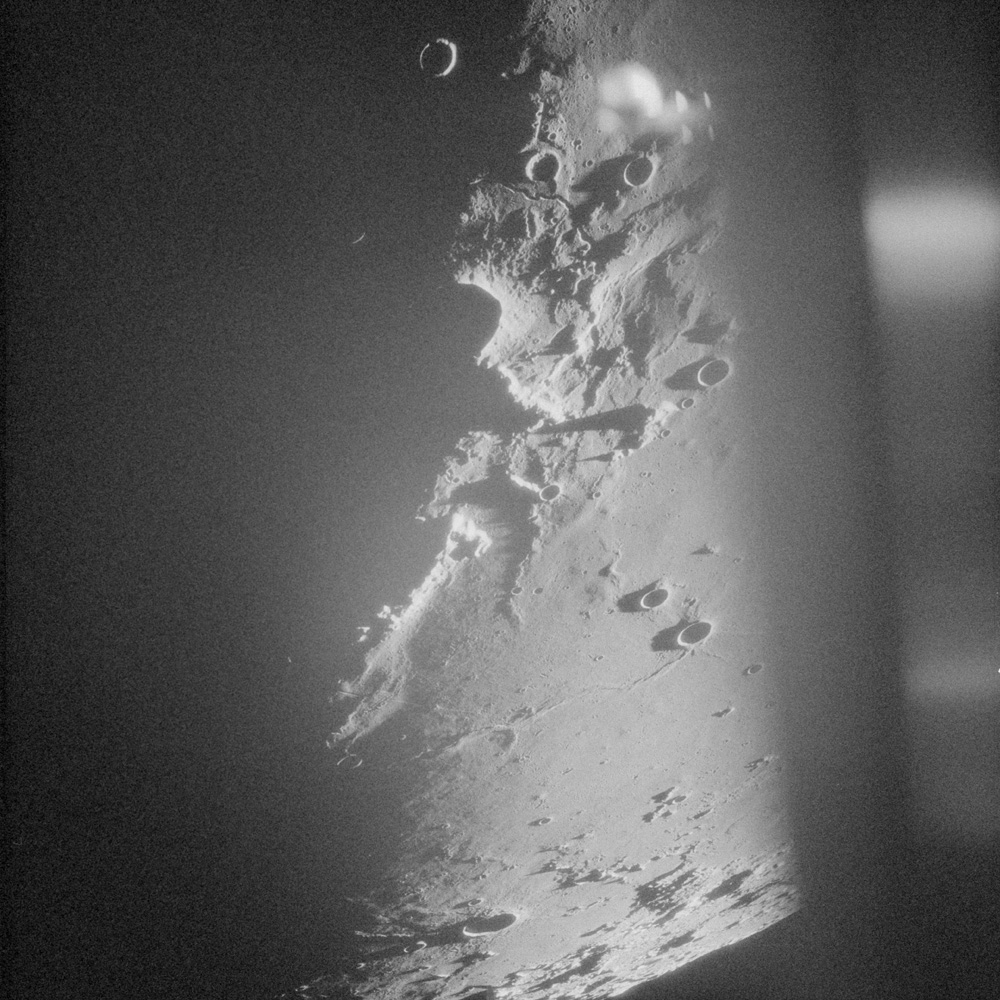
AS17-154-23616 - Jansen, K, L, Sinas, E - NARA archives
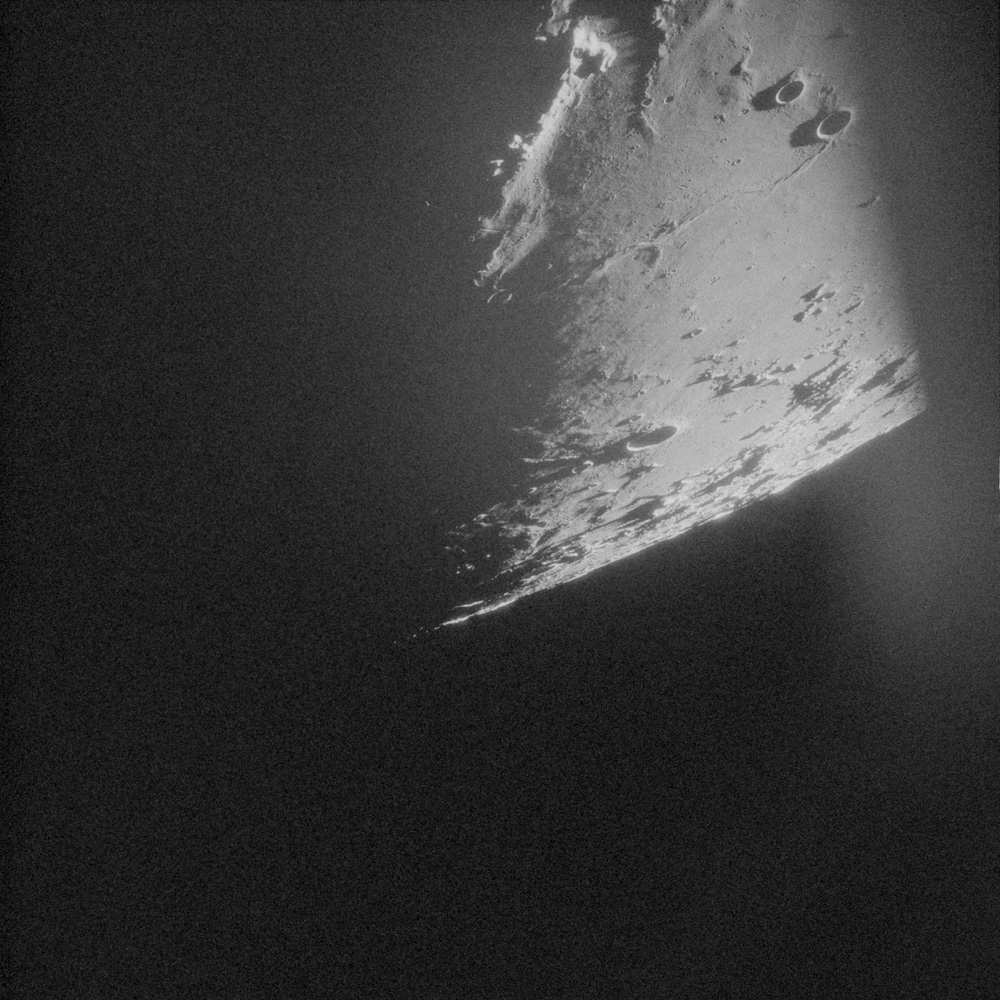
AS17-154-23617 - Sinas E - NARA archives
089:43:04 Schmitt: Boy, I tell you, there's no question that right at the terminator you - you pick up relief that you normally would not believe is there in the mare. I remember Bill Anders talking about the appearance of a sea swell within the mare itself and that's certainly clearly shown right at the terminator. Plus you start to see the shadows from all the very small craters that otherwise don't show up as much more that just little depressions, if that.
089:43:35 Fullerton: Okay. We need Accept so we can give you a landing site REFSMMAT.
089:43:44 Evans: Okay, you have it.
089:44:06 Schmitt: Yes. Okay, I think that will do her. Okay, Houston. I cheated. I took three extra pictures, and those were at 2.8 and a 250th at the end.
089:44:22 Fullerton: Okay, Jack.
089:44:25 Schmitt: And, your - actually your times might have been a little off, because I was just about ready to lose the terminator because of the maneuver - are we maneuvering or have we? Yes. But, I think we got a good set going up to the terminator.
089:44:50 Fullerton: Roger.
089:44:51 Schmitt: Plus a couple of shots - a few shots on the CEX mag Quebec Que - No, mag Kilo Kilo as we came around the Moon and that number's now on 20. Kilo Kilo is 20, and Quebec Quebec is 42.
089:45:16 Fullerton: Okay, we need the IR, On, now.
089:45:21 Schmitt: Okay, back to work.
089:45:28 Fullerton: It's your computer; the uplink's in there, and you can go back to Block.
089:45:30 Schmitt: IR going On...
089:45:32 Schmitt: Mark it.
089:45:45 Schmitt: Yes, enough - enough tourist activity.
089:46:02 Schmitt: Warm in here, isn't it?
089:46:15 Fullerton: America, a couple of items. Would you verify the S-Band Aux TV switch is in the Science position? And one other thing, we think you were in Low Bit Rate during the burn.
089:46:32 Schmitt: Okay, it's in Science and we very definitely were in High Bit Rate during the burn by the checklist.
089:46:39 Fullerton: Roger. We may have a problem there because it looks like Low to us on the data. We'll check further.
089:47:01 Schmitt: Hey, Gordy, there was - Ron questioned - brought up the question or possibility of not having gone to Command Reset; but, just before we left you, you'll probably be able to see that I went Command Reset and turned on the tape, because I remember seeing the tape motion.
089:47:18 Fullerton: Okay, Jack. We're discussing it - what happened there.
089:48:35 Fullerton: America, you can go back to Block.
089:51:52 Schmitt: Okay, Houston. How do you read 17?
089:51:55 Fullerton: You're loud and clear, Jack.
089:51:59 Schmitt: Okay. Before we really got concentrating on the burn, and I had an opportunity to - we all had an opportunity to look at Korolev, at a very low grazing Sun, one of the striking things was the - to me was the extreme absence of relief, the very smooth surface that existed in Korolev, independent, of course, of the craters that are penetrating that surface. And it looked like there was a ring in the floor - outsi - next to the wall, about maybe one-sixth of a crater radius, that was somewhat brighter at the low grazing Sun, suggesting it may have had a different slope. And I believe I'm correct in saying that the inner floor may be slightly raised. We'll try to make other observations this next time around on that one, but there was just a very smooth floor. The light plains material in that crater is very smooth.
089:53:13 Fullerton: Okay; understand. One quick word from FAO's...
089:53:18 Schmitt: And, of course, that's independent...
089:53:19 Fullerton: ...film watchers here, has to do with optional photographs. We'd rather you take the optional photographs on either OO or PP and reserve KK for the scheduled photographs. And, as it stands now, we've got to reserve 80 frames on either OO or PP for scheduled photography. Over.
089:53:42 Schmitt: Okay, you have to keep track of that. We need - I was hoping we had an optional capability on our first rev, and we'll work it out.
089:53:53 Fullerton: We do. We just want to put them on OO.
089:53:59 Fullerton: That's right; just stick them on OO.
089:54:48 Fullerton: Jack, the problem on the high and low bit rate there was a synchronization problem between you on the burn checklist and us on the ground on our pre-LOS command. No hardware problems, and I don't think it will be a problem in the future.
089:55:08 Schmitt: Okay. But you did lose the high bit rate. is that correct?
089:55:11 Fullerton: That's affirmative. We just had low bit rate during the burn.
089:55:18 Schmitt: Okay. I may have jumped the gun on you there a little bit. But I thought we were supposed to do that just before we went AOS - LOS. I think I did it about a minute before.
089:55:32 Fullerton: Okay. It was almost identi - simultaneous with our sending the command. You've got about 4 minutes to start looking at Copernicus coming here.
089:55:44 Schmitt: Okay. Thank you. We're just - Sun's just setting.
089:56:07 Schmitt: Okay, I have a visual on Copernicus.
089:57:05 Fullerton: And by the way, the S-IVB crunched in on time, and it's been ringing the ALSEP seismometers like mad for some time now.
089:57:42 Schmitt: VOX, and that's VOX. How do you read the LMP, Gordy?
089:57:45 Fullerton: Loud and clear, Jack.
089:57:48 Schmitt: Thank you. Okay, good. All right, I've got a visual on Eratosthenes and Copernicus. The - they are obviously different-age craters in this light. You can see the ray patterns in Copernicus moderately well. You can even tell that they do cross Eratosthenes. Stadius shows up as a very clear dark area to the southwest of Eratosthenes. Now, one of the things that we mapped on the southeast and south rim of Copernicus were dark albedo areas within the ejecta. And those are apparent here, very clearly. And also, within - on the upper portion of the rim and on the benches, in that quadrant. The walls - there are the dark spots - lower albedo material that we mapped. They are - form linear patterns along the benches, apparently. Although the bench - the topography is not too clear. But the dark spots are in arcuate linear arrangement parallel to the rim. And they appear to have - be elongate along radius - along the radius of the crater.
089:59:34 Fullerton: Roger, Jack.
089:59:36 Schmitt: This is in the southeast - southeast quadrant I'm referring to. Copernicus H is also very obvious as a dark-rimmed crater, relative to the albedo of the ejecta blanket. And the northwest quadrant, which we mapped as a smooth floor material and somewhat darker albedo, is just as apparent here, although all the contrasts, of course, are less. The main thing that you can pick out in Earthshine are albedo distinctions. Now - now we - we - I remember that we also, at one time - and I can't remember whether it made the final map or not - mapped an arcuate fault structure, based on the change in albedo. And this was on the southwest quadrant of Copernicus. And that crossed the southern rim, more or less north-south, went down and curved across the floor and up the southwest rim, and that is a very clear arcuate pattern in this lighting. Darker albedo than the rest of the crater. And along the arc, there appear to be a couple or three even darker spots - much as we thought we saw in some of the early photography.
090:01:23 Fullerton: Roger.
090:01:24 Schmitt: There is a general streaking - radial streaking - within that arcuate dark area that radiates radially from the crater, and if I had to project, the dark area would - north - whose northeast terminus is the arc in the crater, I'd project it off to southeast about crater diameter and a half, maybe. Now there's - I'm getting - essentially directly overhead, and again the dark spots within the crater wall are still apparent, and the streaming or the radial elongation of these spots is clear. Now, on the lower wall - that's below the first bench - I can see four of these dark areas, and on the next wall above that, above the first bench, there are two - two obvious ones and a couple that are somewhat more subtle.
090:02:43 Fullerton: Okay...
090:02:44 Schmitt: In the middle of the...
090:02:45 Fullerton: ...Can you see anything of the - that stuff we were wondering about in the central peaks?
090:02:51 Schmitt: No, Gordy, I can't. The - there's very little indication of relief in Earthshine and particularly at this high Sun ang - high Earth angle, pardon the expression.
090:03:07 Fullerton: Roger.
090:03:08 Schmitt: The central peaks do stand out, though, as a much lighter albedo area within the crater. It looks to me like the best thing you can do in Earthshine is work with albedos. Knowing the general topography from the - from the pre - earlier photography. We're coming up on Kepler now. Copernicus is out of my view in window 5 - Maybe Ron sees it. Do you, Ron?
090:03:44 Evans: No, it's out of my view now, too.
090:03:49 Schmitt: Okay, we, we...
090:03:50 Cernan: Can you see Reinhold over there?
090:03:53 Schmitt: Reinhold, I was not conscious - Yes, I can see Reinhold. Reinhold is one of the craters just like Copernicus that may have contributed ejecta into the Apollo 12 soil. Do you see anything...
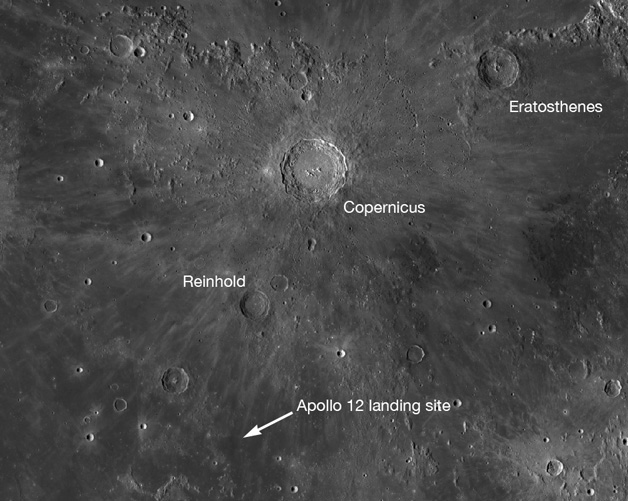
Image from Lunar Reconnaissance Orbiter of the major craters north of the Apollo 12 landing site. (NASA/ASU)
090:04:05 Evans: An S - an S-IVB - 16's S-IVB hit out there to the south, I think.
090:04:10 Schmitt: Well, I don't...
090:04:12 Evans: No, I don't think you'd see it.
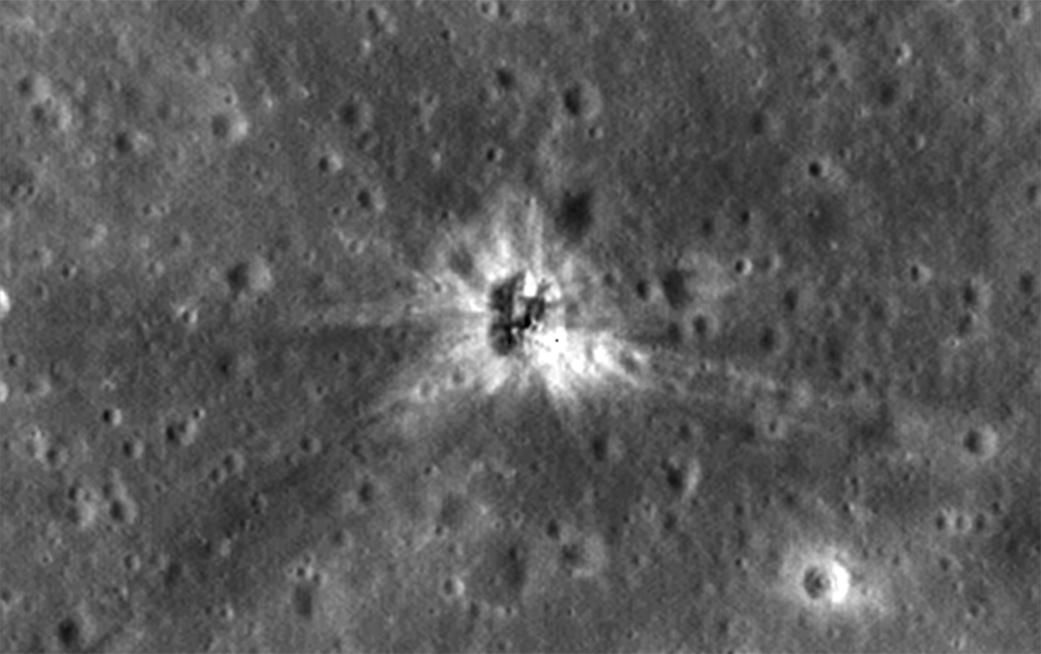
Image from Lunar Reconnaissance Orbiter of the crater formed by the impact of Apollo 16's S-IVB third stage. (NASA/ASU)
090:04:13 Schmitt: I don't see anything that would indicate that. Reinhold is an Eratosthenian Age crater, as you may recall. It's crossed, very obviously even in this light, by the Copernican rays, which is prime - the main way we determine the age, other than it doesn't have any rays itself. Although, on the good photography we now have, we know it has secondary crater patterns around it.
090:04:41 Cernan: You're not looking at the same crater I am then.
090:04:46 Schmitt: Reinhold is right down here, Geno.
090:04:47 Cernan: Where are you looking [garble]?
090:04:48 Schmitt: Well, it's south of Copernicus.
090:04:50 Cernan: Okay, I'm looking up here.
090:04:52 Schmitt: South and a little west.
090:04:54 Cernan: I don't have the same view you have.
090:04:58 Schmitt: Okay, I can see Lansberg now. And I'm afraid I can't shed any light, pardon the expression, on the old question we've had about the age of Lansberg relative to the mare.
090:05:16 Fullerton: Okay.
090:05:25 Schmitt: Kepler ray pattern is very striking in this light, An anastomoting - mosing series of - of bands which only average being radial. In most cases, they're a little off radial, but by joining together, they give you a general radial pattern.
090:05:50 Cernan: I just wanted to see a...
090:05:52 Schmitt: Okay. Out the window 4, I have an excellent view of Kepler. Once again, albedo differences, such as the - are very clear - such as the distinction between the wall - light - or brighter wall materials and the rim which, in itself, is brighter than the surrounding mare. We can look right down some of the rays, and the rays are not completely linear. I'm looking now to the northwest. Gene, you can see Aristarchus way up there in the northwest. See it?
090:06:31 Cernan: Yes. It's coming into [garble].
090:06:32 Schmitt: You ought to have a good view of Aristarchus. Very bright, up in the northwest part of our field of view.
090:06:37 Cernan: The inside of that crater almost looks as if it's backlit.
090:06:41 Schmitt: That's right. Well, it should be [chuckle]. Strangely enough.
090:06:45 Schmitt: And - but I want - these rays when contrast to the - maybe the feeling one would have that they are - once they get started, they form a linear pattern across the surface. They don't seem to have done that. As a matter of fact, they're quite strikingly curved along their pattern. They'll break from the general radius they're out on, curve away and then curve back. Some - all - let's see, there are one - one, two, three, four - four rays that go from out - to the northwest of Kepler, all of which show that nonlinear characteristic.
090:07:33 Cernan: Yes, they're all radial, though-
090:07:34 Schmitt: They are radial, in general. But when you look at them in detail, only portions of them are radial. And a single ray, which you can follow continuously, will bend and then curve back.
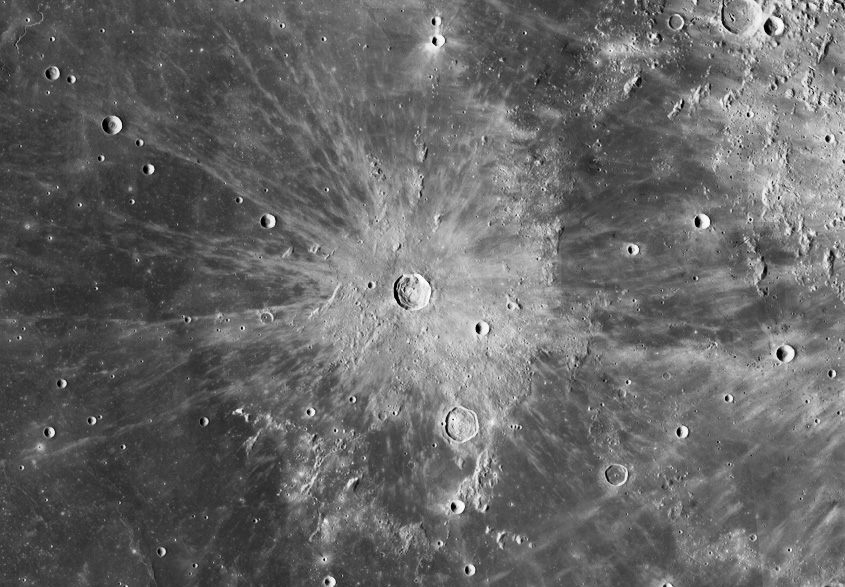
Lunar Reconnaissance Orbiter image of the crater Kepler, contrast enhanced to show the ray system more clearly. (NASA/ASU)
090:07:49 Evans: The - it's unique. We've got rays from - I guess those must be Copernicus over here - those long ones out to the right, which you might not be able to see. Kepler and Reiner are all - all intermingling up here.
090:08:05 Schmitt: Yes, this is the area now we're going over where the gamma-ray work on 15 indicated a relatively high radioactivity. And - not yet, it's...
090:08:25 Evans: Houston, America here. Do you see the torquing angles?
090:08:31 Schmitt: I was going to look for the Hortensius domes near Copernicus, but got sidetracked with Kepler and missed them.
090:08:38 Fullerton: Okay, [garble] torquing angles, Ron.
090:08:39 Schmitt: They are not obvious, though, in looking in the general direction...
090:08:44 Evans: Okay, I'll torque it to 8:45.
090:08:47 Fullerton: Roger.
090:08:56 Schmitt: Okay, we're getting out into Procellarum - Oceanus Procellarum proper now and, before long, should pick up the medial ridge that makes that mare so distinctive from the other mare. Actually, the ridge that stretches something like 2,000 kilometers north to south, if you want to tie a vari - a number of things together. And, probably is the lun - the Moon's closest analogy to an oceanic ridge, which has - which have been in the news over the last decade.
090:09:34 Fullerton: Roger.
090:09:50 Schmitt: Once again, the topography of the Procellarum Mare is not clear in this light. It's just not quite enough light to give you strong, distinct shadows, at least not yet at this Earth angle.
090:10:07 Fullerton: Okay. And as you get the camera set up for the orbital science pictures of Galois would want to change and use magazine OO instead of KK. That's listed in the Flight Plan at 90:20.
090:10:24 Schmitt: Okay, we'll - we'll do that.
090:10:32 Schmitt: Okay I'm - out of the window 4, I'm able to see some of the Rima Gamma materials, and it's - awful hard to say more than just the fact there is a very clear light-colored pattern off to the north - of our position at any rate. I think all I can say is that I've seen it. I can't give you much information on it.
090:11:17 Fullerton: Okay.
090:11:20 Schmitt: We can see the area where Marius Hills should be, although it's not an obvious topographic feature in this light. Still see Aristarchus off up there shining like a star, if the Moon could have stars.
090:11:41 Evans: Okay, Houston. I'm going to torque those cos - coarse align errors out at 1, 2.
090:11:49 Fullerton: Roger, Ron.
090:11:55 Schmitt: And...
090:12:03 Cernan: You squared away?
090:12:08 Evans: It's good to be able to see some stars out of the telescope. It's the first time I've been able to see any.
090:12:14 Schmitt: Gordy, we have a - a very clear zero phase point for the Earthlight. It's certainly not a strong contrast for the Sun, but it's out there. And within it, again, the fresh craters tend to brighten - quite a bit more than the surrounding mare. Still looking at Oceanus Procellarum. And now, out window 3, up to the northwest, Grimaldi is starting to show up - a very obvious dark area within the highlands of that part of the Moon - and one of the darkest mare regions that we have seen on the - on the Moon. It's comparable, at least in the photographs, to that of Tsiolkovsky.
090:13:26 Fullerton: Roger.
090:13:27 Schmitt: Normally, of course, we think of the dark mare as being the younger basalt flows that - on the Moon, but in our case, of course, young means something on the order of 3 billion years or older.
090:13:45 Fullerton: Roger.
090:13:45 Schmitt: For our interp - If we can extrapolate from the samples returned by other missions.
090:14:04 Schmitt: Amazing how far over - now the highlands to the west of Procellarum are - still are bright, and the contrast between fresh craters and the normal highland are very - are very obvious still in Earthlight, particularly along the zero phase point with respect to the Earth. Rima Gamma [means Reiner Gamma] now is - is coming a little bit closer to our oval track in the horseshoe in the - larger and more western end of it; the dark horseshoe is quite clear in this light. It's a west - or northwest-pointing horseshoe, as is the complete trend of that strange feature. I think Ron is going to have an excellent chance to study these light-colored swirls within the mare and other parts of the Moon. We had some good views of them and Mare Marginis and to the east of Crisium - Mare Crisium, and he should - if there is anything to be seen, he should be able to see it for - during the next few days.
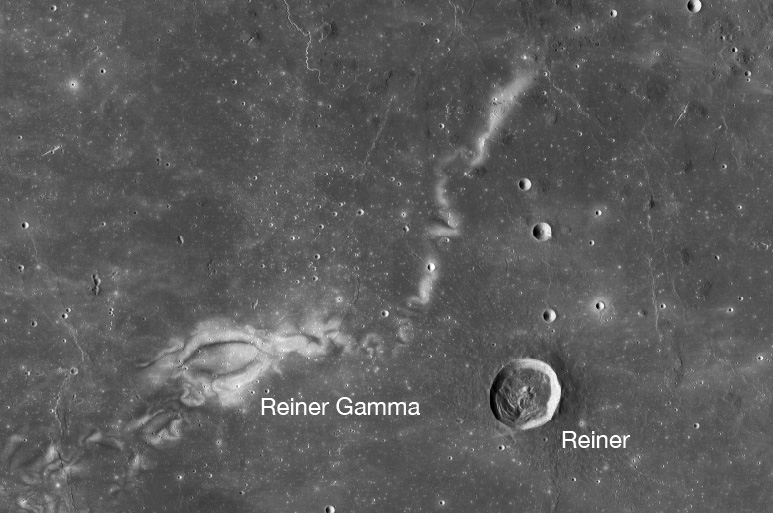
Image from Lunar Reconnaissance Orbiter of Reiner Gamma, West Oceanus Procellarum. (NASA/ASU)
090:15:36 Fullerton: Okeydoke.
090:15:51 Cernan: Say, Gordo, something I just noticed here in working with the GDC what have you. I - looked at the PC gauge, and in the PZ - PC position, there is a continuous bias on it now of about, oh, 7 percent, and if I switch to ALPHA, it goes to zero. We never saw that bias before this last burn.
090:16:16 Fullerton: Roger, Gene.
090:16:35 Schmitt: Hey, Gordy, I'm looking right up the western edge of the Procellarum mare where it contacts the - the - the high - western highlands of the Moon, and we're just about to fly a little bit south of Grimaldi. That edge is very irregular. There is no obvious indications that it - there are large basins that have been flooded by mare that have formed that edge, but, again, the topographic distinctions possible in this light are small. Now I'm starting to see that there are shadows in the craters.
090:17:22 Fullerton: Roger.
090:17:23 Schmitt: That's the small craters. There, in the Mare Procellarum closest to Grimaldi, there are two arcuate rilles. Looks like they're probably V-shaped in their cross section. I'm sure we've seen those on the photographs much better than I can see them here. Those - the rille patterns, though, do seem to project over into the highlands.
090:18:03 Fullerton: Okay.
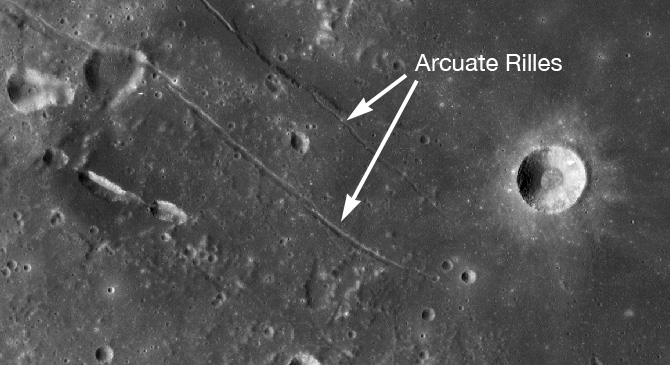
Image from Lunar Reconnaissance Orbiter of Jack's arcuate rilles. Click for larger context. (NASA/ASU)
090:18:04 Schmitt: To the north of that - to the north of that bay of mare. Just interrupt.
090:18:11 Schmitt: Hey, I just saw a flash on the lunar surface!
090:18:16 Fullerton: Oh, yes?
090:18:18 Schmitt: It was just out there north of Grimaldi. Just north of Grimaldi. You might see if you got anything on your seismometers, although a small impact probably would give a fair amount of visible light.
090:18:32 Fullerton: Okay. We'll check.
090:18:34 Schmitt: It was a bright little flash right out there near that crater. See the crater right at the edge of Grimaldi. Then there is another one north of it. Fairly sharp one north of it is where there was just a pin prick of light.
090:18:51 Fullerton: How about putting an X on the map where you saw it.
090:18:52 Schmitt: I keep looking occasionally for - yes, we will. I - I was planning on looking for those kind of things. Starting to see the edge of Orientale, Gordy. Way off to the west. Hey, just yell, Gene, anytime you...
090:19:47 Schmitt: Gordy, to the north of Grimaldi there is a large basin that is about the same size but only incompletely filled with mare in its northeastern quadrant. The rest of it looks like a fairly irregular and hummocky floor material of some kind.
090:20:11 Fullerton: Roger.
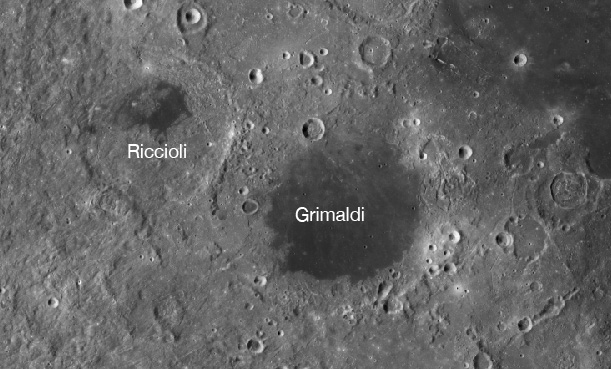
Image from Lunar Reconnaissance Orbiter of Riccioli and Grimaldi. (NASA/ASU)
090:20:12 Schmitt: But it's almost the same size as Grimaldi. It even looks like it is a little bit deeper, but, of course, Grimaldi has considerable fill. Grimaldi on its eastern edge has some of the graben, or it's rim, if you will, is cut by three or four anastomosing grabens that make it look like some of the bench areas in the larger basins.
090:21:00 Schmitt: Okay, the first ring of Orientale is showing up. The inner - next ring in is extremely obvious; got some very bright east - east-facing slopes.
090:21:17 Cernan: I'll turn off the intercom.
090:21:24 Schmitt: It has some very bright east-facing slopes, and you can see the bands of mare that are filling the - both the first bench area and the inner bench.
090:21:53 Schmitt: Any time you need us, Gordy, just interrupt me.
090:21:57 Fullerton: Okay; we'll do that.
090:22:03 Schmitt: Now, as I look north along the first bench, that's the first bench from the outside, one inside the Cordillerian ring. I better check that; I may have my names mixed up. Got Orientale, there - handy? [garble] see. Should be on there. Yes, this is what I need. What's the name - they got a name on that ridge, there? That's Rook Mountains. Yes, the Cordillera. Yes, that's right. Looking just west of the Cordillera on the first bench, as I look north, in this light, which is casting some shadows now, Gordy, over in here, it looks extremely smooth. Now this is not mare; it's lighter albedo, lighter reflectivity than the mare, and, although there are patches of mare in the lower areas in it. But looking along that plain, in fact, a lar - a long linear plain, it - it looks quite smooth with only some very broad undulations that appear to be roughly radial to Orientale itself. The more - closer we get to it, the more I see minor relief showing up. I start to see the shadows, I guess. And that relief seems to bring out a hummocky texture in - in addition to the craters you would expect to see there.
090:23:59 Fullerton: Roger.
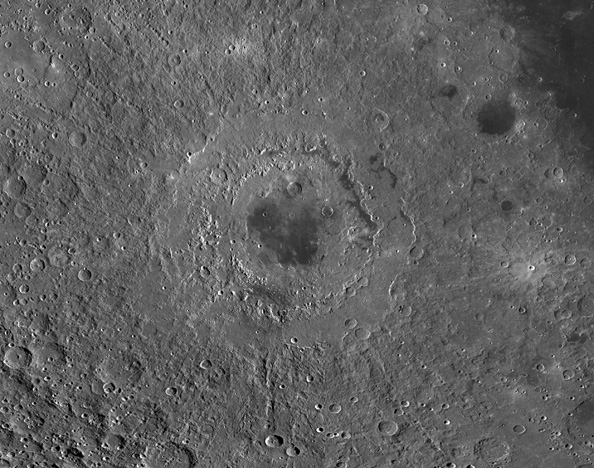
Image from Lunar Reconnaissance Orbiter of Mare Orientale. Click for larger image. (NASA/ASU)
090:24:00 Schmitt: I won't try to give you a trend on the hummocks because I think the shadows are biasing my view; they do appear to be north-south trending, but I think that is because of the shadow patterns. This is a spectacular sight, you guys; you ought to take a look at Orientale. One of the largest fresh basins on the Moon. It still is probably 4 billion years old, or 3.8 at any rate, if our dating criteria are any - any good. It has the outer Cordillerian ring and the inner ring called the Rook Mountains - very, very nicely shown. There are massifs on that inner ring, the Rook Mountain ring; there are massif complexes much like what we'll be studying at Taurus-Littrow. There are low areas, non-mare areas, that are comparable to some - to the Taurus - the valley that we'll be landing in. And, all in all, I think we'll find that our ring in the Taurus-Littrow area around Serenitatis is comparable in many regards to this Rook Mountain ring around Orientale. You want - did you interrupt, Gordy?
090:25:34 Fullerton: No. I didn't say anything.
090:25:38 Schmitt: Okay; I thought I heard your key. Okay; in the inner portion of Orientale, as we approach a terminator, the lighting is still excellent. Matter of fact, it appears brighter than what we were looking at over at Copernicus. Now, part of that may be we're seeing much sharper relief since the slope - Earth-facing slopes are nicely lit, and the backfacing slopes, of course, are in shadow. The first portion of the bench inside the Rook Mountains is partially filled by mare. Now, the higher land in there is very smooth - in a gross sense, is a very smooth hummocky terrain, cut by roughly circumferential grabens. The trend of the hummocks themselves are not radial; they're more - well, they're about a 45-degree angle to the radius. They, in detail, have a much finer hackly texture, much like we've been able to see on photographs before. And, in general, you get the impression that, in several areas here, that that hackly textured surface is draped over material that resembles the massifs of the Rook Mountains themselves. There's one area just to the north now of our track where there's a large, roughly equidimensional mountain mass, with a few projections of massif-like peaks through this hackly textured surface.
090:27:47 Fullerton: Roger.
090:27:47 Schmitt: There are also some radial grabens; I just now picked one up, which we've also seen on the Orientale photographs taken by Lunar Orbiter. It's amazing how fresh appearing this basin looks, considering its great age. But it's - it probably is not - had any more violent a history than Imbrium. Now, we're getting up, just about to go over a delta-rim crater that's out in the basin. I don't remember the name of it offhand. But it's - be familiar to some of the geologists who have mapped this basin. It does not appear to have a strong impact ejecta blanket around it. It's filled with mare, and it's quite sharply in contrast to a crater of comparable size to the northwest. See that one, Ron; I don't know whether you can get it. I get a good view out of 5 now of that one. And, once again, it looks as if this hackly-textured material that forms the higher hills in the inner bench - has a draped appearance over the, over preexisting terrain, and, in fact, along the ridges of the hummocks, you - we now can pick up little rilles that roughly parallel the hummocks, although not - not - not consistently. They do cross down into the valleys. But it has appearance that there may have been a tensional relief along the crest of each of the hummocks, or many of the hummocks.
090:29:53 Fullerton: Roger.
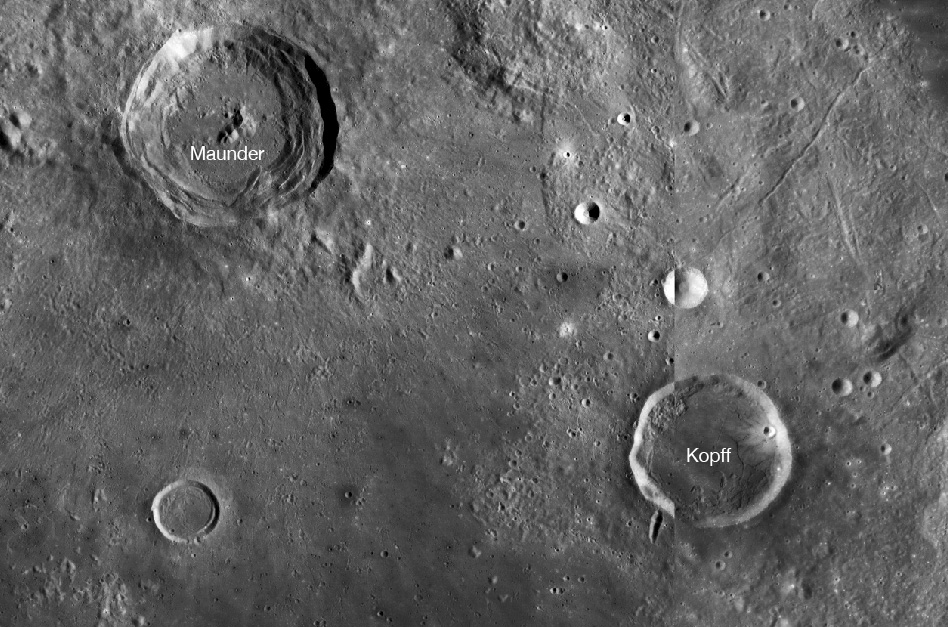
Image from Lunar Reconnaissance Orbiter of Maunder and Kopff, both within the central section of Mare Orientale. (NASA/ASU)
090:29:53 Schmitt: Delta-rim crater just as has been, I think, discussed in the literature, has just that, delta rim with no obvious ejecta blanket around it, compared to other larger craters within the basin. We're directly over that crater right now. It's filled with mare, very smooth mare. Matter of fact, within that fill, I can see no - no craters. Getting very close to the Earth terminator, but you see good texture in the ejecta blanket of the large crater [Maunder] in the north part of the inner basin of Orientale. The radial ridge and valley patterns are very clear; the concentric coarse hummocks near the rim are apparent; and you can even see the second - patterns of secondaries, the larger secondaries, extending out away - radially out away from that crater. The south - the mare fill in the south floor of Copernicus, I mean of Orientale, is very smooth but does have the sea-swell texture that we saw over in Tranquillitatis.
090:31:30 Cernan: Better let him say something before AOS.
090:31:40 Fullerton: I ain't got nothing to say.
090:31:40 Cernan: Houston, I guess we're getting close to AOS. We're getting close to AOS. Do you have some words for us?
090:31:51 Fullerton: Okay. We show about 9 minutes to LOS. We'd like to clarify one thing, and that was on this tape recorder commands and high and low bit rate. And we just want to make it clear that preburn the 6-minute callout is High Bit Rate, Record, Forward, Command Reset. Did you - did you tell us a few minutes ago that you did indeed do all those at about 6 minutes?
090:32:26 Schmitt: Yes, Gordy, I certainly thought I did, but I can't specifically - I know the High Bit Rate was there, because we switched to Low later. I can't - I'm afraid I can't specifically verify the Command Reset.
090:32:43 Cernan: Gordy, I can specifically say that when those - after the bus stars came on, we called that out. I'm almost sure Jack did get it, because I had him then check the helium valves and the nitrogen - helium and the nitrogen valves.
090:32:58 Fullerton: Okay. We're just trying to make sure if we - or to determine if we do have a switch problem. The INCO did send Low Bit Rate, Command, just prior to - to LOS there before LOI, which is the way it's called out in the Flight Plan. And then you should have come along later with a Command Reset, setting the switch to High Bit Rate, and the Command Reset switched into High Bit Rate mode, and for some reason it did not go into High Bit Rate.
090:33:41 Schmitt: Well, you want to test it out here, before we go around?
090:33:46 Fullerton: That's a pretty good thought. I think we will. On stand by. We'll give you - we'll figure out how we're going to do it here.
090:34:25 Fullerton: Okay, Jack. We just now commanded Low Bit Rate, and you're in Low Bit Rate. We'd like you now to select High and Command Reset.
090:34:41 Schmitt: Okay. Gordy, you also have an oscillation in uplink signal strength and a clicking in the - in the audio. Do you read? We just went steady and at about 60 percent - 70 percent signal strength.
090:34:59 Fullerton: Roger. We hear that.
090:35:03 Schmitt: Okay. I'm going to - you want me to go ahead and command High and Command Reset?
090:35:11 Fullerton: That's affirmative. The High Gain just went Wide Beam, but we're still reading you loud and clear. Go ahead in High Bit Rate and Command Reset.
090:35:20 Schmitt: Okay. High Bit Rate; Command Reset.
090:35:36 Fullerton: Okay; it seems to have worked properly, Jack.
090:35:39 Evans: ...after AOS...
090:35:40 Schmitt: We're going to do a Verb [garble].
090:35:XX Evans: Manual and Wide, minus 5 and Yaw, 15.
090:35:46 Schmitt: Okay, Gordy. I may not have got the Command Reset at 6 minutes. I - I - I just can't tell you right now.
090:35:XX Evans: Those are the SIM bay jets. Okay. Let's go. Let me go ahead and do that. Yes.
090:35:XX Schmitt: ...and [garble] let us know [garble].
090:35:XX Cernan: Can I do that in P20?
090:35:XX Evans: Yes, you can do it.
090:35:XX Evans: You've got A/C Roll going?
090:35:57 Fullerton: Okay; I want to assure you it was no big problem as far as the burn goes. No great loss there.
090:35:XX Cernan: Which ones you want?
090:36:08 Schmitt: I hope not.
090:36:32 Fullerton: America, Houston. About 5 minutes to LOS now. We'd like to have you go ahead and get the jet inhibits and the covers open as shown in the Flight Plan so we can see that before we lose you.
090:36:48 Evans: Okay. IR Cover, Open, and - Well, let's inhibit the jets.
090:36:XX Cernan: What other jets you want on?
090:36:XX Evans: A-1 and C-2, On.
090:36:55 Cernan: Oh. Two On. Go ahead.
090:36:XX Evans: A-3 and C-4.
090:37:00 Schmitt: Okay; Gordy. IR Cover is coming Open.
090:37:04 Schmitt: Mark it.
090:37:05 Fullerton: Roger.
090:37:XX Cernan: A-3 and C-4 are On?
090:37:XX Evans: Yes.
090:37:05 Cernan: Going On.
090:37:XX Evans: B-3 and D-4.
090:37:XX Cernan: B-3?
090:37:09 Evans: Yes, and D-4. The ones with the arrows on them.
090:37:12 Schmitt: Okay; UV Cover coming Open...
090:37:XX Cernan: Okay. I don't have many special things right now, but...
090:37:13 Schmitt: Mark it.
090:37:XX Evans: That's all right. Okay.
090:37:16 Fullerton: Roger.
090:37:20 Cernan: Bs are Off.
090:37:XX Cernan: Bs are Off. That's right. They're supposed to be. It's A-1 and C-2.
090:37:25 Schmitt: And you want me to stay in High Bit Rate?
090:37:XX Cernan: Okay.
090:37:XX Evans: Okay. IR, Open...
090:37:28 Fullerton: That's affirmative. You're there.
090:37:XX Evans: ...Yes.
090:37:XX Fullerton: You're going to have to do it in a minute anyway, so since you're there already, stay there.
090:37:XX Evans: High Bit Rate, Recorder going.
090:37:38 Schmitt: Okay. We're there; we've got tape motion.
090:37:43 Fullerton: Okay.
090:37:49 Cernan: Gordy, the deadband - or the A/C - B/D, A/C roll has been changed, and you should have the proper jet configuration now.
090:37:58 Fullerton: Okay. We see it; it looks good, Geno.
090:37:05 Cernan: Okay. After AOS, Omni Delta.
090:38:49 Evans: IR and the UV. Might as well open up the Mapping Camera/Laser Altimeter, too.
090:38:59 Schmitt: Okay; if you're still with us, we're going to Open up the Mapping Camera/Laser Altimeter Cover.
090:39:04 Fullerton: Okay, Jack.
090:39:XX Cernan: Okay. Would you Extend the Mapping Camera, and give them a mark so we can time it?
090:39:XX Schmitt: [Garble].
090:39:XX Cernan: Yes. Give them a mark too.
090:39:28 Schmitt: Okay. We're going to Extend the Mapping Camera.
090:39:XX Evans: Yes, I'll catch this. Yes.
090:39:34 Fullerton: Roger on that.
090:39:35 Schmitt: Okay. Okay.
090:39:38 Schmitt: Mark. Barber pole.
090:39:42 Fullerton: Roger.
090:40:03 - This is Apollo Control. We're estimating a change of shift briefing at 3:45 Houston time. One minute and 16 seconds away from Loss Of Signal on this first lunar revolution. Participants in the Flight Director change of shift briefing will be Gerry Griffin who has been in charge of the Gold flight team, Dr. Royce Hawkins the Flight Surgeon, and Charlie Dumis the EECOM. At 90 hours, 40 minutes Ground Elapsed Time; this is Apollo Control.










